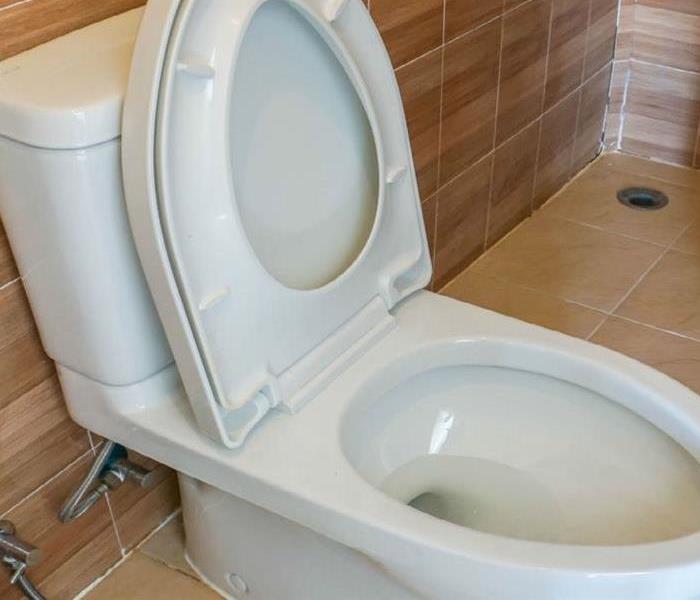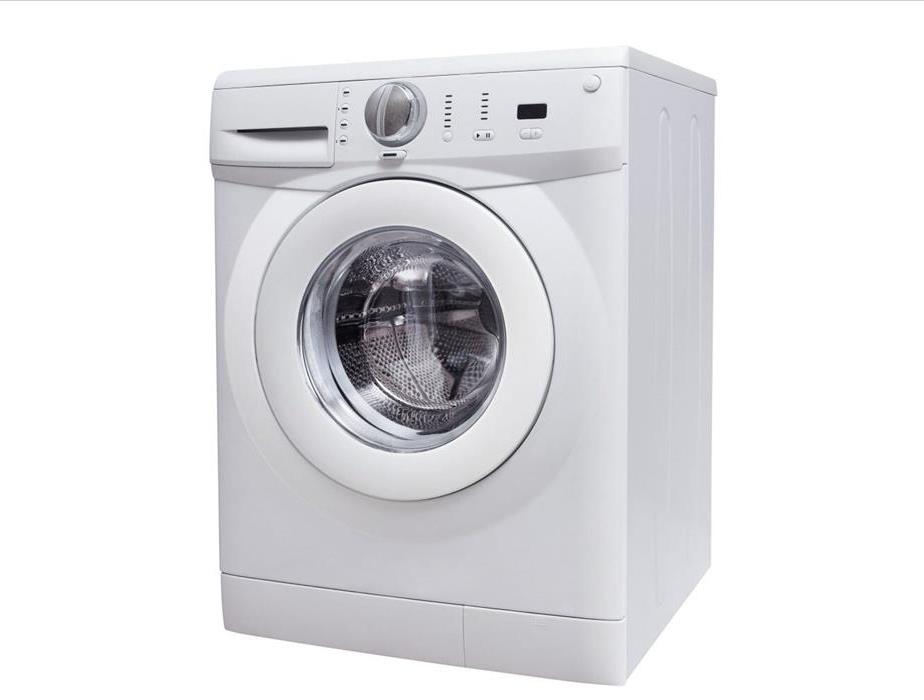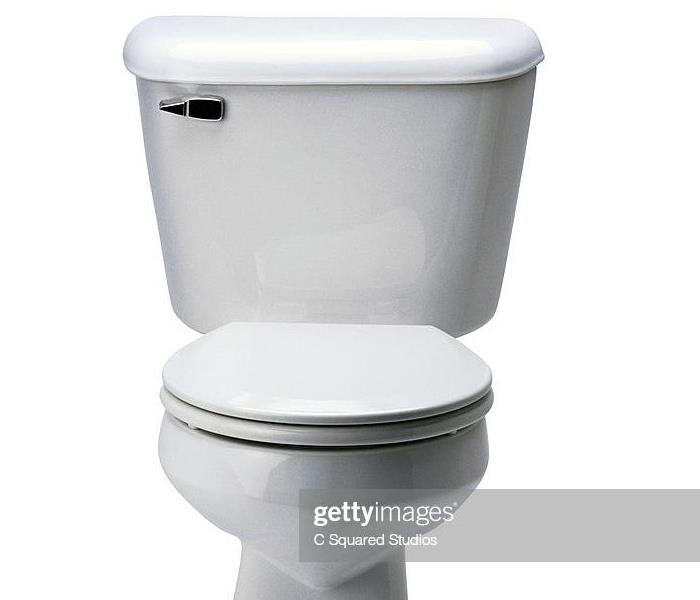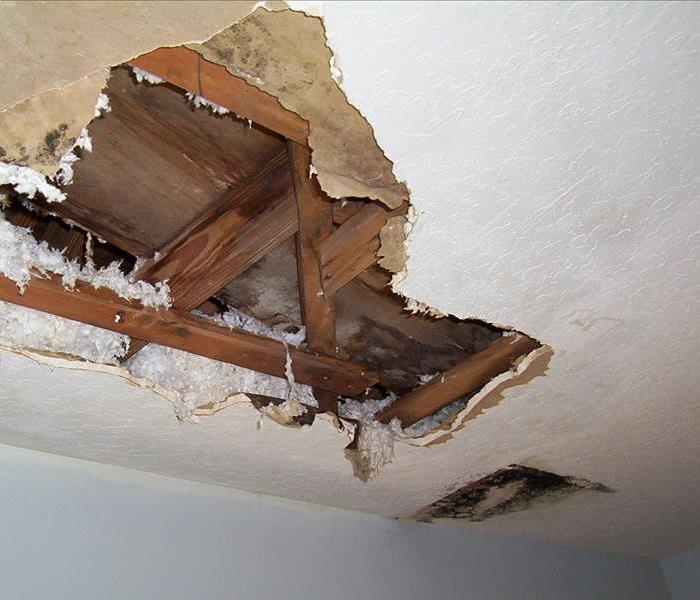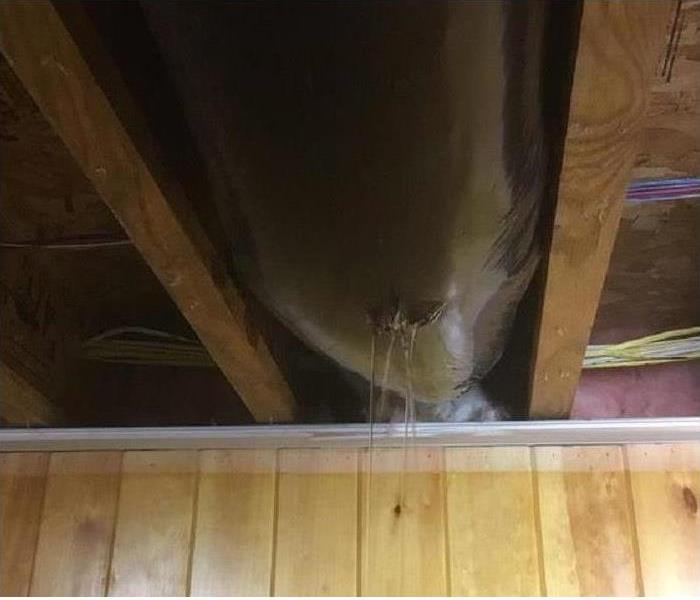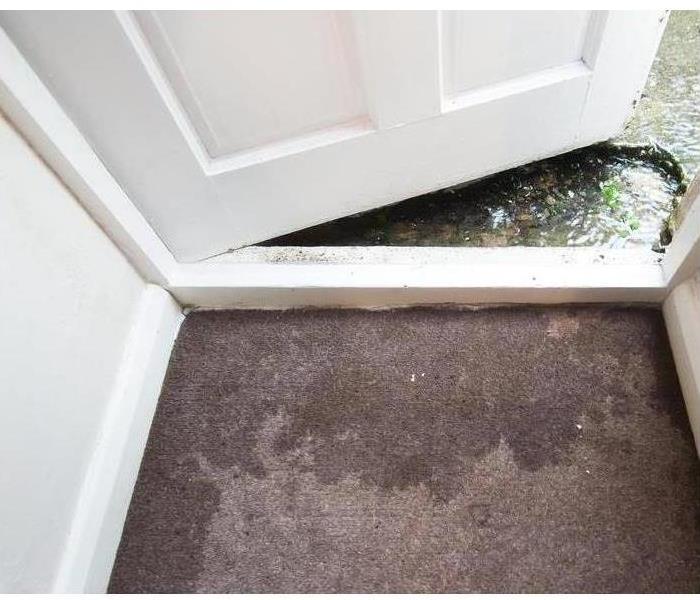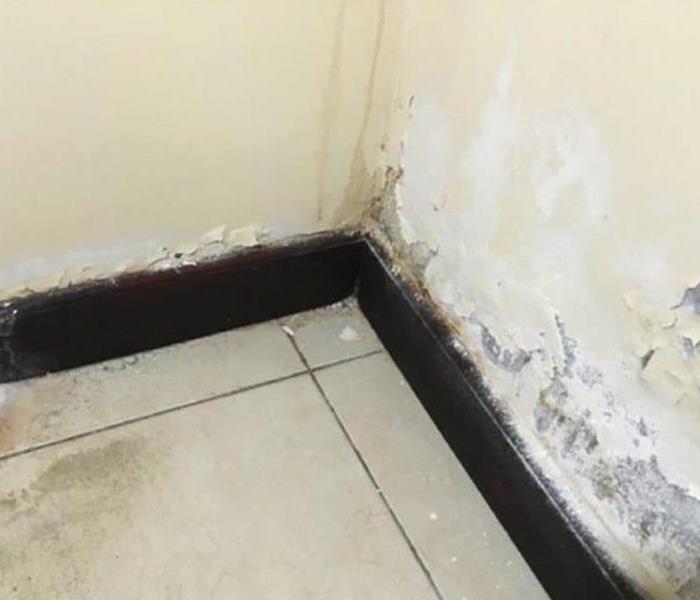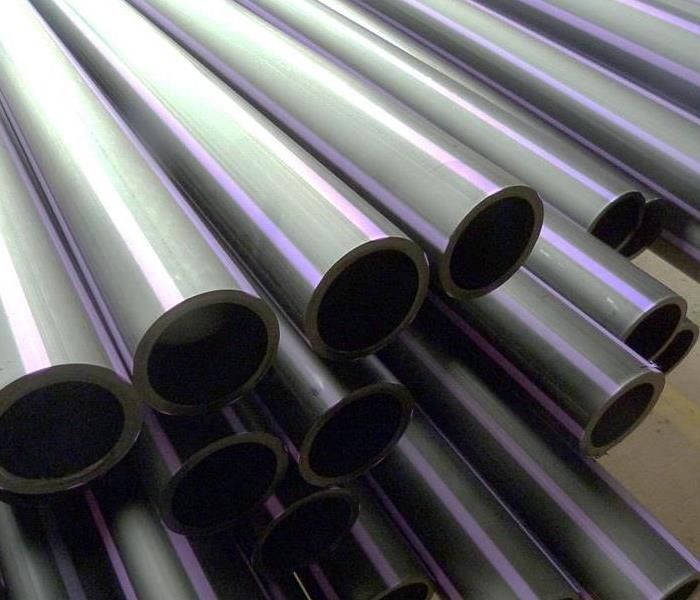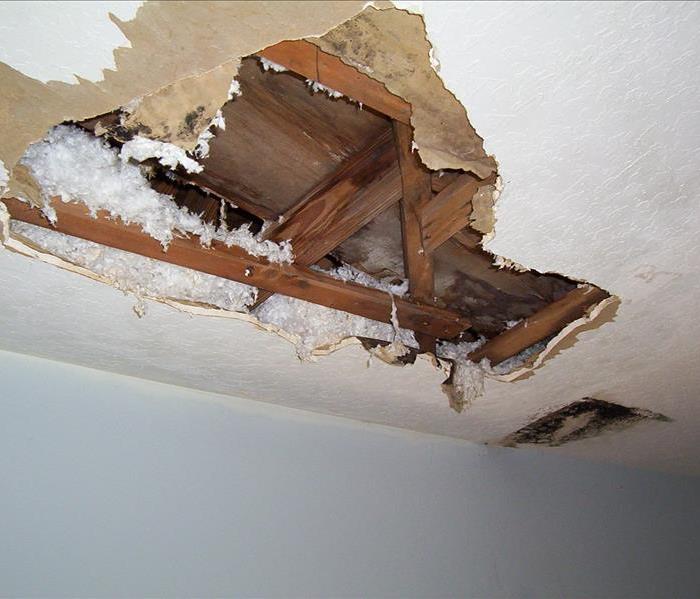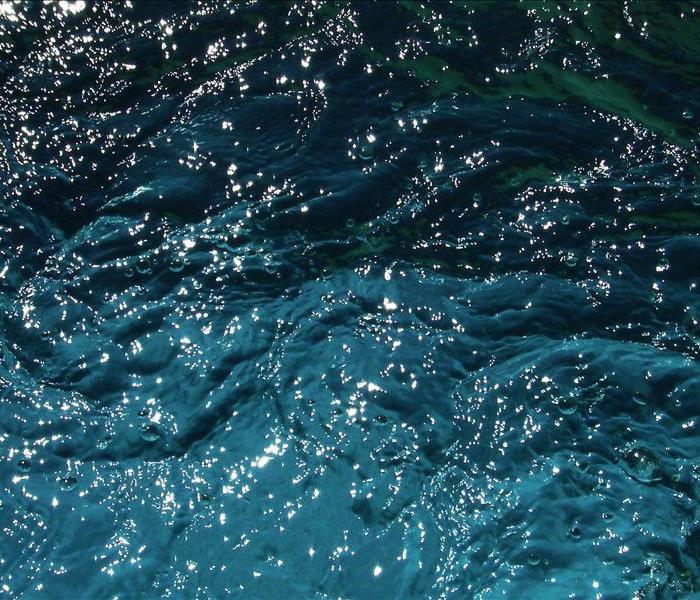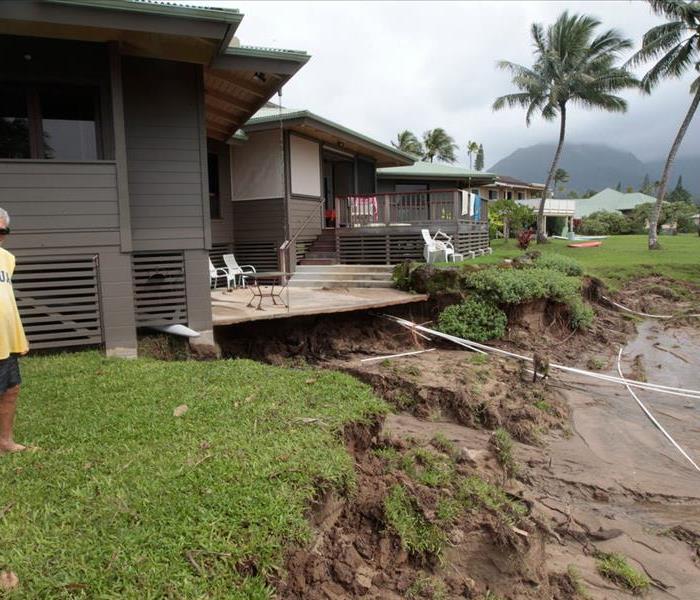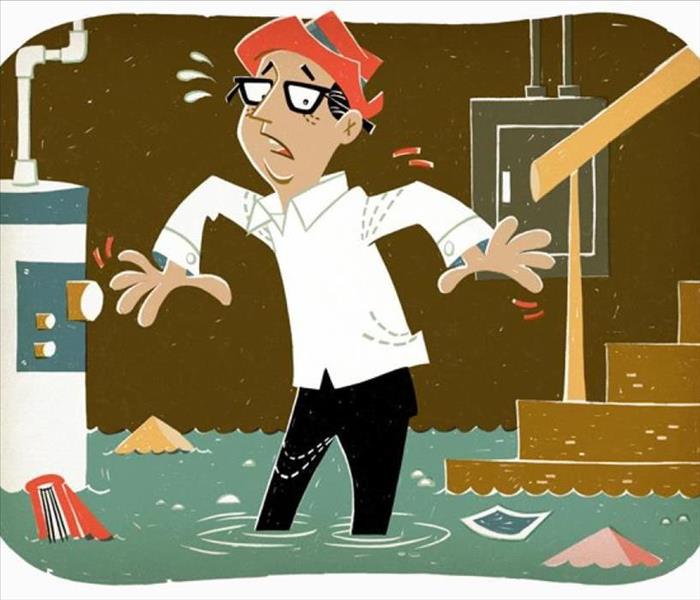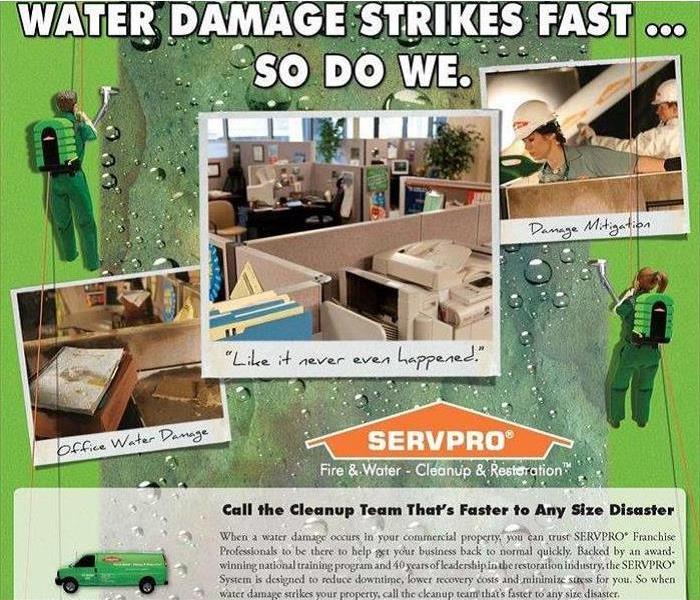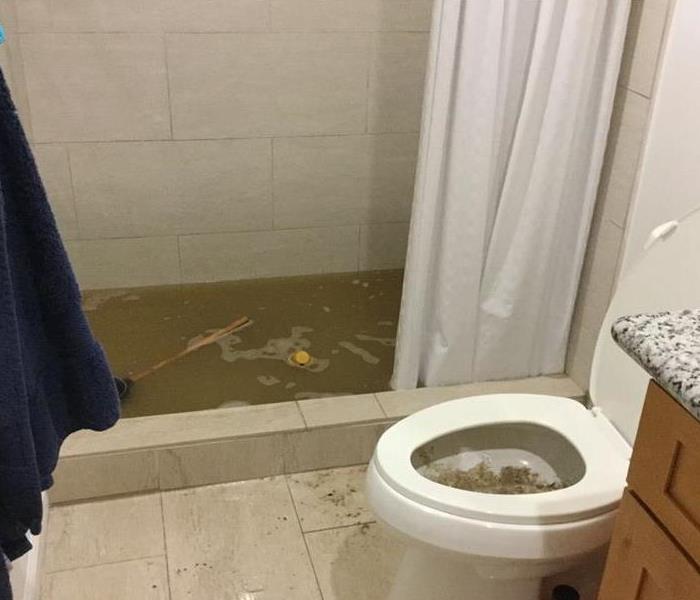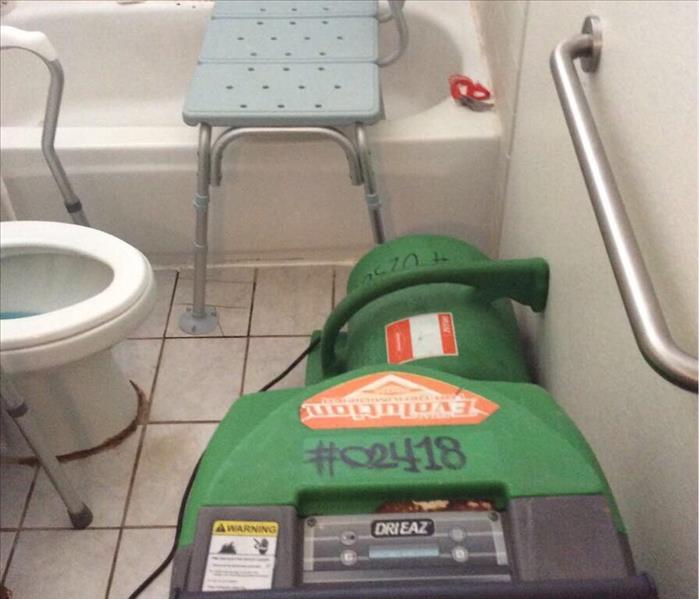Archived Water Damage Blog Posts
How to spot ceiling water damage
6/30/2023 (Permalink)
Identifying and repairing ceiling water damage quickly is vital to the health of your home. Water damage can create a lot of issues if it is left untreated, so it is important to know how to spot it and get it fixed as quickly as possible. If you have damage from water in the ceiling of your home, it’s not just in the drywall. It came from somewhere, such as from a leaky roof or a bathroom that is leaking on the second floor, there is also going to be damage in between the floors, in the attic or crawlspace, and any areas in between where you physically see signs of water on the ceiling and where it originates.
SIMPLE SIGNS TO LOOK FOR
While there are many indicators that a ceiling has water damage, some are easier to spot than others. Before calling in professionals for a full evaluation and estimate of the damages and repairs needed, you can determine what type of damage is occurring and how severe it is to help them get a better idea of the work that may need to be done. Here are some signs to look for with water damage:
-Odors, such as a mildew smell
-Sagging ceilings
-Discolored splotches or stains on the ceiling
-Peeling paint or wall surfaces
-Crumbling or cracked drywall
Keep in mind that even a small stain on the ceiling could be indicative of much bigger issues, so never assume you don’t need professional remediation and repair services to resolve your water damage issues.
FIX CEILING DAMAGE AND LEAKS ASAP
Water damage that is left untreated can result in mold growth and further damage to the home. Plus, if you don’t identify the cause of the damage and repair whatever is leaking, you are only going to continue to have issues with ceiling damage in the future. Make sure that once you’ve identified ceiling damage caused by water, you call a professional restoration service to help repair your ceiling and resolve the root cause of the damage.
QUICK TIPS TO FEND OFF FURTHER DAMAGE
If you notice water damage, use the following tips and precautions:
-Immediately clear the area of valuables, furniture, and other items that may be damaged if the ceiling collapses or water breaches the drywall.
-Use a nail to poke a hole in the ceiling and let out any water that may be pooling on the opposite side of the drywall.
-Use your fingers to test the ceiling. If you poke it and are able to break through or make an indent in the spongy drywall, water has already breached the ceiling. If it appears intact and solid, whatever damage or discoloration you see may be from a previous repair.
-Cut off the source of water that is causing the damage, if you can. That will prevent further damage while you await a restoration team or repair service.
-Let the professionals do the big repairs and ceiling damage restoration jobs. These trained technicians know how to completely remove water damage and other resulting issues. They can replace the drywall and any boards that may have also been damaged by water. Plus, hiring restoration services allows you to remove the threat of mold and reduce the risk of future.
Water Damage: the Timeline // SERVPRO of East Honolulu
6/1/2023 (Permalink)
We understand water like the back of our hand! SERVPRO of East Honolulu is proud to host technicians who have the experience and the qualifications to correctly do their job. Which we boast about and helps you in the long run.
We aim to categorize your damage accurately, and with precise measurements, controlling the whole process. As if we were to take your home in our arms artfully replacing damaged goods- in the tangible. Because of this we know the water damage timeline, and learned how to generally gage this on the field.
Here is how it goes, as explained through the time since the water damage occurred and the original source is stopped.
MINUTES 1-22
- Water is absorbed through housing materials, completely saturating all sponge materials.
- This affects anything from floors, walls, upholstery, and house-hold belongings. Vinyl tends to get extremely damaged, as does wood finishing and drywall alike.
- Paper goods are starting to warp, swell, bleed, or blend; this completely damages books, documents, and photographs.
- Carpets, curtains, or furniture will also start to bleed, these pigments will stain
THE FIRST DAY
- Drywall starts to bulge
- Finishing on metal will fade
- The dyes and inks of household matters/items will continually spread
- Malodorous scents start to appear
THE FIRST WEEK
- There will be physical manifestations of both mold and mildew
- Warping will start to happen in doors, windows, and openings and furnishes alike.
- Furniture or finishing with water damage will start to show mold and mildew
- Completely deteriorated metal finishing, will start to corrode or rust
- Paint jobs will start to discolor, falter, peel
- Flooring also warped
- The presence of bacteria accrues enough to be deemed a biohazard
AFTER AND BEYOND
- Damage is getting more costly by the day, replacing the contaminated materials would be the top priority. Secondary damage is already happening.
Issues stated above become dramatically worse.
SERVPRO of East Honolulu is here to help with any and all water damage, and our scope goes beyond that. Call us with any comments, questions or concerns at (808)396-9545
Hidden Water Damage in Honolulu
4/1/2023 (Permalink)
SERVPRO of East Honolulu is well versed in continuously occurring water damages. There are many reasons as to why a home has water damage, this manifests in varying ways. It may not be the most noticeable, and more often than not it creeps with age.
We were called in once to inspect a home that had suspected water damage. Over the course of 10 years a hairline fissure in their copper piping caused odors and discoloration on their drywall.
Undetected water damage is quite the headache for numerous reasons, here are some signs that you may have hidden water damage:
- Peeling paint: paint can start to peel when there is an unsustainable amount of water within your drywalls.
- Drywall is like a sponge, when there is no dry surface for the paint to attach itself to then the paint starts to peel. This is a sign of major water damage, since the drywall needs to be very wet.
- Warped flooring: Water will always be looking for the lowest point of Earth- partly due to gravity and its molecular properties. Water will flow and seep into the deepest parts of your home if left unchecked. If water reaches your sub-flooring it is time to call us at SERVPRO of East Honolulu. Warping and deforming floors are the best indicators that your sub-flooring has water damage.
- This sub-flooring is where mold can grow and multiply, thus it is integral to the safety of your property for there to not be standing water underneath.
- Staining on walls or ceilings: These stains will be slightly discolored and range based on the type of water damage done.
- For instance, if there was rain and your ceiling leaks, the evidence of water damage would arise from corners of rooms, mostly the ceiling being discolored. It may also manifest as long lines of discoloration. Where pipes or streams have come across your walls and ceilings.
- Mold growth: Occasionally there could be “fuzz” on your ceiling corners which originally look like webs or dust and may be mold. Mold accrues from the sitting water damage, mold spores are microscopic and most often airborne.
- If there are discolored patches of drywall within your home that may be a good indicator that water damage has occurred.
- Malodorous smells: If you smell something earthy or a little “dank” that may also be a sign of water damage. Basements should not smell like mildew, and if they do it's a sign that there has been standing water recently.
- Any smell that seems spoiling, could be the water compromising clean building materials. And if not removed, these compromised materials can affect more housing goods.
Keep your house safe by knowing the small- creeping- signs of water damage. And if anything arises, or you seem to find them in your home… SERVPRO of East Honolulu is there for any damages. Call us at (808) 395-9545 for any concerns about these kinds of water damages and its implications to your home. We are available 24/7. "Like it never even happened."
Categories of Water Damage// SERVPRO of East Honolulu
2/1/2023 (Permalink)
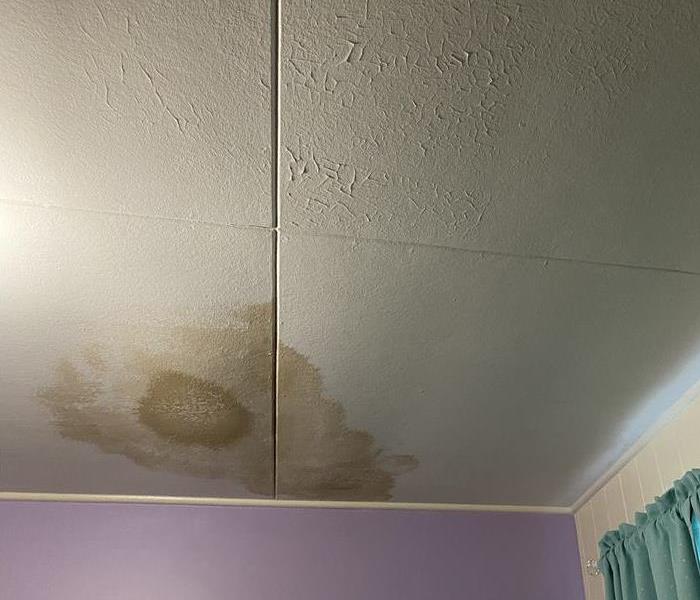 This is compromised materials that need to be removed immediately. It is showing signs of bacterial growth, and contains contaminates.
This is compromised materials that need to be removed immediately. It is showing signs of bacterial growth, and contains contaminates.
There are three different types of water damage that incur, these descriptions are based on the water loss source: where it came from. The most common sources here in East Honolulu are broken water, sewage pipes, defective appliances, storms/hurricanes or structural failures.
These disasters can happen to anyone whether it is on personal or commercial property. Understanding what category your water damage is allocated is crucial to understanding our solutions and treatments.
There are certain steps needed to do the various kinds of water reparations and remediation.
To understand the full treatment would also mean understanding your flooring and drywall drying status and damage.
Category One: Clean Water
This means that the water should not have any contaminants in it nor have ever been used. This kind of water would be found from overflowing sinks or broken pipes. This is the easiest water damage to deal with and poses little life threat. Other than the potential to grow mold if untreated.
Category Two: Gray Water
Cat 2 is called gray water because it has been used and carries waste products that are not human feces. This is water that isn’t exposed to animal fecal matter, and would occur in damages from overflowed washing machines and toilet overflows that were not filled with matter. It is more dangerous than category one water and can expose one to diseases and bacteria if consumed and/or touched.
Category Three: Black Water
Black water is the most dangerous water category for an organism's health. Category three water is unsanitary water that comes from floods or sewage. This water does possess bacteria fatal to health and equally possible chemical contaminants.
These colorization of categories may not be accurate to your case of water damage, the color of water itself varies from each personal damage.
- Like one may have Cat.3 water damage from a storm, and the water drying is clear; it is still known as black water because of the possible properties it possesses which are harmful to health.
It should be equally known that the longer water sits it gains the ability to classify in a higher category.
- Water being soaked into your building materials and goods are exposed to the air and bacteria- consequently mold spores. The longer water is on a site the “dirtier” it gets.
Thus mitigation is integral to preventing dangerous water damage to accrue on your property.
- This secondary damage can be seen as anything like musty odors to warped flooring, carpet delimitation or mold growth.
We aim to save as much as your property as possible, the faster the water is removed-regardless of category- the less damages will occur. Knowing these categories also determines the final treatment of the affected area.
- Keeping mold prone ceilings are harmful in the long run especially to your quality of life.
Removing it as soon as the damage happens saves you money over time.
SERVPRO of East Honolulu prides itself in creating a service that helps you along the way of the whole restoration process.
"Like it never even happened." Call us, 24/7, at (808)395-9545
Common Instances of Water Damage
3/28/2022 (Permalink)
There are four general reasons as to why water damage occurs in a residential property- whether it is an apartment or house alike.
Indicators of water damage are universal, yet the whole restoration process needs to be curtailed to the niche property it occurs on.
That’s why you contact us, SERVPRO of East Honolulu when disaster strikes. We can ensure that the proper treatment is issued for your home, and your ohana is safe… "Like it never even happened."
These are the four main causes of water damages we encounter in the East Honolulu area.
Build-Up
Water build-up is the silent yet deadly handling of water damage. It comes over time, slowly, without the owner noticing the longest. Any amount of leakage from your pipes increases your water bill. Water pooling from the resulting leak tends to also remain hidden to any user of the pipes. Virtually, most leaks have to be sought after. Which is why a spike in your water bill is the best indicator of a leak without physically seeing it. Habitually look at any of your pipes, if there are any too cool areas inside your home or mold growth in dusty corners. It makes all the difference catching a water leak sooner rather than later.
Broken Pipes
The most destructive way a home can receive water damage. This is caused by high-pressure and a small hole in the pipe.Even the tiniest of cracks can cause a pipe to burst if over exerted. In a matter of hours, or minutes your whole property can be flooded with any pipe's contents.
Weathered Materials
Weather wear can also lead to various water damages, make sure that you know your local weather. As it is different for different parts of the island. Make sure that you are proactive in protecting your housing materials. This is the best way to stop damage. It is not fun being prepared for the worst case scenario, but it is always better to be overdressed than under.
Faulty Appliances
The last most common water damage we are going to talk about are malfunctioning appliances. Anything from an outdated refrigerator or copper pipes can be considered faulty appliances. There are tons of building materials that are outdated or ineffective after a while, which can cause major issues. Make sure that your house is refurbished to maintain the integrity of your property.
But if all else fails, your friendly, neighborhood technicians are always willing to come help clean it up… "Like it never even happened." Call us at (808)-395-9545 with any questions, comments, or concerns.
What to do if a Toilet Overflows in your Eastern Honolulu Home
11/15/2021 (Permalink)
No one can pick and choose when they fall victim to bathroom issues- of any kind. It is inevitable for any bathroom user thus, it must be universally known how to handle such a situation like when the toilet overflows. And if you have not before, let SERVPRO of East Honolulu walk you through it;
Once you flush and there are some signs that an overflow may occur,
- Start to remove the lid of your septic tank, be careful not to break or chip it in any way. Locate the fill valve or the float and keep it lifted up to prevent the toilet from refilling the tank over and over again. Fashion something to make sure that the float stays up.
- Next thing is to turn off the water supply to the toilet, one most often finds these valves at the base of the toilet on either side of the bowl.
- Finally to turn off all water supply to the home and appliances until you or a professional plumber deem it so.
But above all, do not try to flush your toilet, this will result in more overfilling at a quicker rate. If it looks like a more serious problem do not hesitate to call your local plumbing company-in the long run it is cheaper to hire a competent plumber than run to youtube.
And if you have experienced significant water damage from a toilet overflow call us at SERVPRO of East Honolulu (808)395-9545.
We know water damage, especially from toilets, like the back of our hands. SERVPRO of East Honolulu aims to revolutionize the industry with our gentle hands guiding you through the whole remediation process, and perhaps the restoration. We talk to you one on one about where you would like to get your new flooring from. We break that down with your insurance agent- who approves how much they will pay or not pay for your choice. We also match you with similar patterns or the same as before your damaged carpet, flooring...etc.
The remodeling companies we hire, or work in conjunction with are some of the best on the island of Oahu. Just as much as we take pride in our work, we try to partner with companies with this same mindset.
Toilet overflows can happen at any time of the day causing an emergency, we understand that accidents or emergencies wait on no one. That is why our emergency hotline is available 24/7, we are on call to any accident to make it… "Like it never even happened." We take pride in our work to take care of you and our community of Easter Honolulu. Make an ERP with us today!
Appliances Most Likely to Leak in Eastern Honolulu
11/3/2021 (Permalink)
With the ever increasing use of technology the rise of electronics that use water has also increased exponentially. There are now numerous appliances in an average Hawaiian household that use water and conversely are susceptible to leaking. Sometimes these tools of convenience leak because of micro factors within the home, most often it is from wear and tear, as well as consistent use with no general cleaning.
Your water appliances are not meant to consistently function, especially without periodic cleaning. Hard water is another big factor as to why some of these appliances can leak. The consistent buildup of calcium and magnesium in the water causes issues for pipes and other metal fixings if not properly taken care of.
Here are the appliances that are more prone to leaks or accidents comparably to other appliances within an average American home.
The Air Conditioner
It is important to make sure that your air conditioner is operating properly, and optimally. Especially here in Eastern Honolulu there are probably only a handful of houses that do not have any kind of air conditioning unit in their home. On top of that, the filter within these AC units work exponentially harder than other units. As when on it is consistently filtering the air, picking up small particles that aren’t always good for your health. And if these particulates stay inside the AC machine, mold or other sporadic microorganisms can now habitat within your AC. Improper usage- being used 24/7 for 24 hours, can also cause pipe leaks and other issues with the AC fixings. It is important to clean out the AC unit fixtures every 2-3 months to prevent any real damage.
Dishwasher
Another appliance that is prone to water spillage is the electronic dishwasher. Leaks are very common especially with dishwashers that use plastic tubing to deliver water in and out of the machine. These tubes are prone to breaking and are rather thin, most issues with dishwashers come from the piping design. If your dishes are still dirty after usage that is also an indication that there might be a spill.
Washing Machine
Washing machines are notorious for leaking and continuously leaking. Most of these units need to be replaced every 2-5 years, or if anything some part of the infrastructure needs to be replaced. Washing machines use a great deal of water and therefore have a huge influx of water coming in or out at any given time. Hidden deterioration occurs with machines that are used consistently like any of these appliances. Make sure to give your washing machine breaks that it needs. And to replace your machine at least every 10 years, as well as having it inspected every 6months to 2 years.
Hot Water Heater
This appliance is most ardently the machine that breaks down the quickest. Once one sign of dissonance occurs a whole onslaught of more comes. Water heaters have a 10-15 year duration or warranty. But leaks can occur from any point in time, due to the habitual use of water in American homes. The seals- of any design or material- wear over time from the continuous pressure of water. Additionally the natural degradation of such infrastructure naturally occurs with heat; therefore the heating and cooling process does a number on any chemical. These kinds of leaks can also go unnoticed so it is important to inspect it every 6 months to 2 years as well.
Anything can cause home-owners or commercial owners alike issues with an innumerable amount of appliances. And with the ever changing industry of cleaning, electronics, as well as smart systems. The increased use of electronics in the home setting will only continue to grow. Make sure to research the most optimal design or the best fit for your home, there are so many companies innovating and redesigning everyday appliances. It is important as a user of such appliances to be aware of the movements that occur in the industry.
Call us with any questions, comments or concerns at (808)395-9545- we are here to help the Eastern Honolulu area at any time, any place. Our phone number is a 24/7 hotline because disasters, and emergencies don’t wait for anybody so neither do we. Our goal behind any of our jobs is to make sure that your space looks… "Like it never even happened."
Reasons for Commercial Water Damage in Eastern Honolulu
10/15/2021 (Permalink)
Any sort of natural disaster is unaccounted for and a threat to any business owner in the Hawaiian Isle. Here in Eastern Honolulu, tons of offices, businesses, or non-profits organizations are placed in big plazas, skyscrapers, or buildings that tend to be decades old. These types of commercial properties are prone to water damage just statistically by the innate amount of people occupying square feet. SERVPRO of East Honolulu has been serving our community for a while, we have the knowledge and tools to measure, access, quantify, and actualize a new space- unshaped by the water damage. "Like it never even happened."
There are a few reasons as to why water damage could incur, here are the top 4 reasons for why in the Eastern Honolulu area:
- Bad Weather
- During Hurricane Season, rain starts to get harder and faster, and flooding is more likely to occur. Hurricane season happens from June- November of every year. Although nerve wracking, SERVPRO of East Honolulu boasts numerous equipment pieces that can prevent flooding, or stop it while it is happening.
- Pipe Breaks
- With time our knowledge on pipes, and the ability to carry water has increased. Before copper pipes were the norm, then it was steel, and now it is PVC. Like previously aforementioned, the buildings in Eastern Honolulu range in age just as much as they do size. It is important to recognize that some of these buildings have not been renovated since the 1980s or 1970s. Therefore some of these buildings have antiquated pipe systems, or metallic ones that inevitably erode. Although SERVPRO of East Honolulu knows more about water damage than plumbing/irrigation; we partner with many amazing plumbing companies to make sure our customers are satisfied overall.
- Foundational Issues
- Not only are these buildings prone to wear and tear from being old, these buildings also are found in the capital of our state of Hawai’i! Where it is notorious to be hot, uncomfortable in the summer- amazing every season after. These foundations that the buildings find themselves on tends to expand with the daily temperatures. The way cement works it expands and contracts with the temperatures, which is why asphalt roads, cement sidewalks… etc. crack after a few years. These cracks can host water leaks, creating an environment that supports mold. Foundational issues are additionally dangerous as one tends to notice them when it becomes too late.
Any type of water damage can happen especially in the Eastern Honolulu area. Anyone can fall prey to a toilet leak, a pipe burst, or naturally occurring fissures in foundational layers. We kokua our community by being knowledgeable, and economically feasible for any kind of natural disaster. Our first appointment is free if you call us with insurance. Call us with any comments, questions, or concerns at (808)-395-9545.
What To Do When Water Damage Strikes Before SERVPRO of East Honolulu Inspects your Property
10/1/2021 (Permalink)
My, oh my, how the fall rains have been relentless on our moku here in the eastern area of Honolulu. Many of the other islands have also experienced flooding amongst the slew of problems that occur when harsh weather during hurricane season happens in Hawai’i. In recent events there have been areas of the island with power outage experiences, as well as inaccessibility to driving, or the damage of property. Although this is no surprise, and water damage happens frequently around the island from natural and human sources; it is important to be aware and on your toes before the professionals head your way.
Albeit in some instances there is no need for our SERVPRO of East Honolulu technicians to be there, if it is a tiny amount of water damage that has been dried and disinfected. Our professional services create a safety net between you and your damaged property, it is a big issue nonetheless we are working relentlessly with your insurance company to make it… "Like it never even happened."
While it may be daunting when water damage or storm damage occurs, because everything ever constructed has been proven to be finite; find solace in organized, thorough help and consider some of these statements:
The most important aspect at the end of the day is safety, that the organisms using the property are safe, additionally the property is more or less in the process of becoming safe again. There might be some hiccups in insurance claims, policies… etc is it safe to be in the property? Are there any hazards that our technicians need to be aware about, such as wiring, electrical issues, slippery areas, or pollutants amalgamating to an unpleasant situation they need to be aware of. Materials that have been damaged may have bacteria, and diseases that are a biohazard, do not touch wet materials in most instances of water damage. It is equally important to note wet materials tend to be heavier than when dry.
At the end of the day Safety comes from knowing the means you exist in, what means can fix your house in a safe manner, plus what you can do and not do. Such as lifting heavy materials, living in a home that is infested with harmful bacteria, or just performing unsafe acts.
Until our technicians with shiny ribbons of neon green on their shoulders come knocking on your door. Here are some other methods you can use to help us help you. All excess water should be removed, unless it is an uncontrollable amount. It is imperative to remove all concentration of fluids. Removing excess water from all materials, items, objects that have been damaged will actively halt the damaging process of water. Properly drying out “soft goods”- goods that absorb liquid, is key to the preservation of your home. This drying and removing of water can come and we have seen it in all shapes and sizes. With all paintings holstered up, or loose items on the floor piled outside the apartment in the hall. Preventing further damage from the initial accident is our SERVPRO of East Honolulu mission.
You can not prevent water damage from occurring, when these disasters occur from the elements no one is truly orchestrating it. No one wants the sewage pipes to burst on the side of a building, and until they figure out a continuously safe way of transporting elemental materials SERVPRO of East Honolulu is here for our community. The only thing one can do is the means of what they work with, preventing further damage is the only thing a person experiencing damage can do until help arrives. Call us with any questions, comments or concerns at (808) 395-9545.
Checking Your Refrigerator Saves Money in the Long Run
7/31/2021 (Permalink)
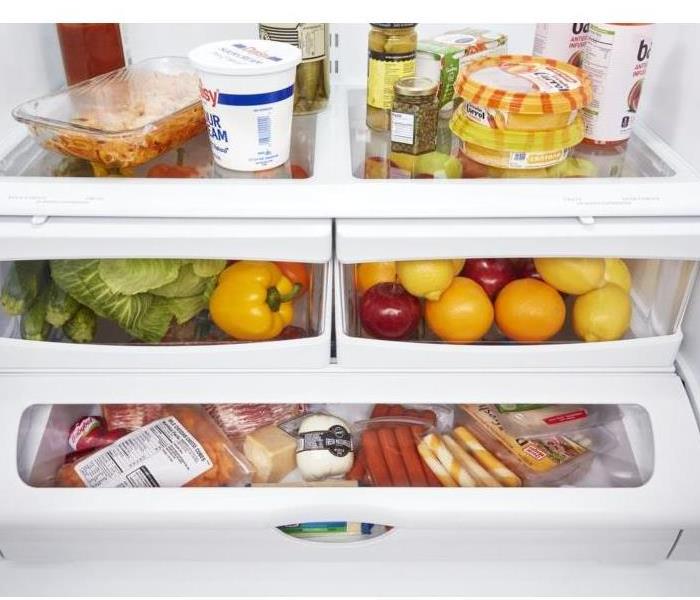 It is integral for an extended life of the refrigerator and for the health of your home.
It is integral for an extended life of the refrigerator and for the health of your home.
A home-owners kitchen houses many integral appliances for good health and a happy home.
Coffee-makers, refrigerator, sinks, dishwashers, and even water coolers may cause water damage.
Maintaining these appliances are integral to ensuring there is no water damage to incur at any point of time. The appliance most prone to causing water damage is the refrigerator; these are also the worst kinds of damage as they tend to start small and progressively get worse with more water leaks.
More so, these leaks tend to start in the back of the refrigerator, out of one’s normal line of view. Common reasons as to why these appliances leak are due to drain blockage, un-leveled flooring and/or the water supply line of the ice maker component.
- Drain Blockage from the Defrosting Component
- The defrosting drain can become blocked after continued use, causing ice or other debris to build up. Not only making your appliance prone to leaking but makes the fridge a little less functional. It is recommended to flush this drain system once every six months or two times a year. To flush the drain simply add one teaspoon of baking soda to hot water. Put this down the drain and the pipe should be good.
- Leveling the Refrigerator Properly
- It is important to make sure that your fridge is slightly higher in the front then in the back, that way the coolant can flow properly within the appliance. This should be checked every time you install new flooring or when once buys a new fridge. The front should be a quarter inch to half an inch higher from the back area of the fridge. When it is not flush the coolant has to work extra hard forcing more fluid in the pipes than need be. This also leads to leaks and stagnant liquid within your fridge causing more issues in the future.
- Watching the Water Line Supply
- It is important to be in tune with your appliance, when ice production is irregular or the flowage on the dispenser this could be there is a bigger underlying issue of a leaking water supply line. To check if it is or not simply pull the refrigerator away from the wall and look at the supply line itself in the back. This line has many different colors for different types of refrigerators, make sure to check the manual before inspecting them. Pulling the fridge too much can cause irreparable damage make sure to check with the utmost care.
Other indicators of water damage is warped flooring or swelling, this swelling when pushed down the water will erupt from it.
Any painted walls near the fridge with swelling, cracking, or bubbling are also good indicators of water damage. Yet the most important step is to find the source of the water damage and to stop it.
And once the source is stopped SERVPRO of East Honolulu can help dry the walls and all areas affected. Even aiding with the restoration process.
Call us at (808) 395-9545
Your Belongings and Water Damage
7/13/2021 (Permalink)
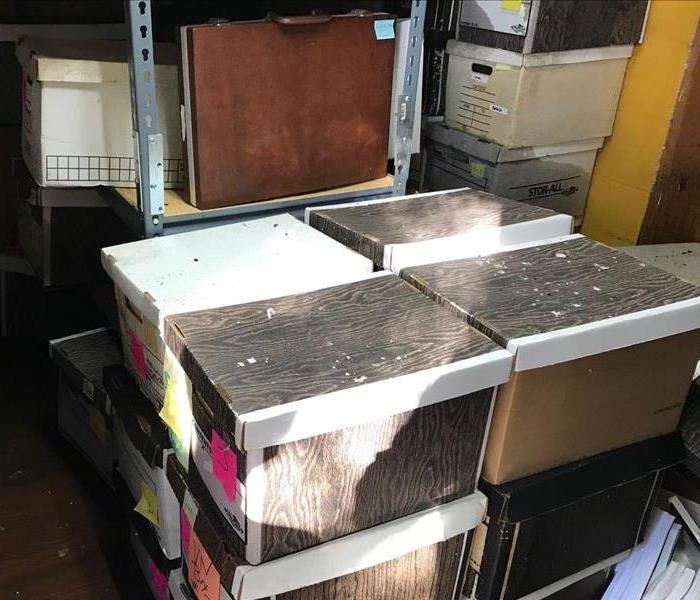 We aim to please, with organized swiftness removing and restoring your contents are no stressor. "Like it never even happened."
We aim to please, with organized swiftness removing and restoring your contents are no stressor. "Like it never even happened."
Water damage from any source affects all aspects of life including your belongings.
SERVPRO of East Honolulu recognizes that your property is so much more than just that. It is a home, work, it holds furniture, keepsakes, clothing, and electronics you and your ohana hold dear.
We help you deal with the aftermath.
Our content restoration process:
SERVPRO of East Honolulu prioritizes restoring your contents that are damaged from natural emergencies. That of fire, water, smoke, or mold. Our expertise helps you all along the way, we firmly believe in restoring your property rather than replacing it. This mindset saves your money and restores all the keepsakes to their condition pre-disaster. There are many ways we clean various contents, done so with;
- Dry Cleaning: a dry sponge used to clean goods that can not be wet cleaned. Removing residue- soot- from surfaces.
- Wet Cleaning: using a disinfectant chemical it is an effective way of removing harsh residue.
- Spraying and Wiping: a good way to thoroughly clean goods that can withstand wet cleaning.
- Foam Cleaning: mainly for fabric that shrink and/or bleed when cleaned any other way.
- Abrasive Cleaning: when we agitate the surface of a material, like sand papering toilets.
- Immersion Cleaning: when contents are cleaned via ultrasonic cleaning baths.
Pack-Outs
You can trust SERVPRO of East Honolulu on a well thought out and organized way of removing contents from affected areas of your property. You can expect a fast remodeling process, with a controlled demolition as soon as goods are away. Your items near the damage will be protected, and all measures needed to prevent further on-site damage are attended to. Although our services of move-outs/pack-outs vary based on your insurance coverage, we guarantee transparency and integrity. Our technicians pack your goods quickly and gently.
Electronics
Water damaged electronics are serious dangers, do not try to turn on any electrical device that could have water damage. SERVPRO of East Honolulu collaborates with many electronic restoration companies for items like,
Assuring that they will be restored by electronic professionals.
Documentation
We document our whole packing process for your assurance. This includes photos before we start any work, the conditions of your goods, and the condition after we have done our treatments. When asked, we also make inventories of items that we are packing. This itemized inventory includes everything that was packed organized by which room they were packed in. Each boxed good or wrapped item is itemized with photos before and after wrapping out the materials. With a barcode.
Call us to learn more about what we do- (808) 395-9545, SERVPRO of East Honolulu is locally owned and operated.
Tell-tale Signs of Water Damage in Your Basement
6/24/2021 (Permalink)
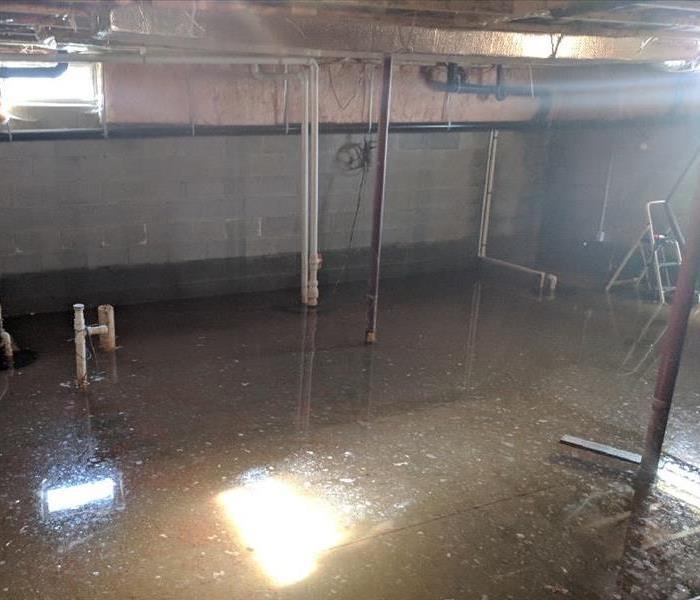 Here are some signs to prevent even greater water damage by being in tune with your commercial or residential building needs.
Here are some signs to prevent even greater water damage by being in tune with your commercial or residential building needs.
Many homeowners in the east Honolulu area have basements. These are an integral part of our homes and our Ohana, being used for many reasons such as storage or another room to hang out in.
Yet basements themselves are inherently a risk to water damage because they are dug into the ground, these risks become even greater when other parts of your home have water damage.
It is easier for water damage to occur at the basement level purely because of their placement within your home.
It may not be your first or second thought to look at your basement after water damage occurs in your home or office.
But it is important to do so because signifiers of water damage in your basement tend to go unnoticed until they are an even greater problem for residential owners and commercial owners alike.
Here are a few signs that your basement has water damage:
It is important to be aware of the tell-tale signs that you are experiencing water damage in your basement, although minute changes. These cataclysmically expound on each other until one is standing in a pool of category 3 water, from a pipe burst that went unnoticed for so long.
- Cracking, Bubbling, or Flaking Wall Paint
Flaking, bubbling, and cracks are strong indicators that water is coming through your drywall or elsewhere. This can also happen in unfinished basement cinder block walls and regular painted walls. These paints whether it is waterproof or not show potential water leaks occurring.
Musky, dank odors occur from a culmination of bacteria growth from still water, incurring a sleuth of other issues such as mold development or air-borne toxins. One may have grown up with an understanding that the basement tends to naturally have such odors, be not mistaken this is an indication of more serious problems and should not be happening. This smell exclusively incurs due to the presence of mildew and/or mold in the area. Mold spores are microscopic and have the ability to stay inactive for years until a hint of moisture is in the air.
Cement, and other foundational materials are not meant to last a lifetime, and experience the wear and tear of life. Cracking can be normal, as cement expands and contracts with warmer and cooler weather. Or even the natural shifting of the Earth creates cracks within your home base. But cracks from the walls, or ceilings may indicate uneven pressure on the house. This pressure could be from water damage, or still water within your walls.
These indicators are major signs of water damage, but alas there is no need to panic. SERVPRO of East Honolulu knows how to assess the damage accordingly, our technicians using advanced technology and trade skills can curtail innovative solutions solving all problems. "Like it never even happened."
Call SERVPRO of East Honolulu at (808)-395-9545
HOW TO FIX A BATHTUB OVERFLOW DRAIN LEAK: 7 SIMPLE STEPS
6/4/2021 (Permalink)
 call SERVPRO of East Honolulu to handle your water-damaged ceiling.
call SERVPRO of East Honolulu to handle your water-damaged ceiling.
First, confirm that the overflow drain caused the flooding. Start by removing the bathtub access wall panel, located in the room opposite the tub faucet and shower head. If you don’t see water dripping from the plumbing, look inside for water pooling behind the wall. Small puddles are sure signs of leaks around the drain pipe or supply lines.
If it looks good, go back to the bathroom, and run the shower. Splash water on the tub faucet, and check behind the access panel again. If you still don’t see water dripping inside the access space, you’re dealing with a bad overflow drain.
These steps fix the problem.
1. REMOVE THE COVER PLATEUnscrew and remove the cover plate. Pull out the overflow drain assembly, including the plug. Take a look at the components for signs of damage.
2. INSPECT THE ASSEMBLY AND GASKETIf parts of the overflow drain are loose, clogged or corroded, replace the entire assembly. However, the source of the overflow leak is usually a worn gasket. In that case, continue with step 3.
3. REMOVE THE OLD GASKETUse needle-nose pliers and your fingers to gently remove the damaged overflow gasket from the pipe flange. Clean the exposed flange and surrounding surfaces with rubbing alcohol.
4. INSERT A NEW OVERFLOW GASKETLubricate the new gasket with plumber’s faucet grease, and take a look at its bevel. Position the gasket over the pipe flange with its thickest side on the bottom. Ease it around the opening in the overflow drain pipe.
5. SECURE AND SEAL THE GASKETCarefully work the gasket into place around the overflow assembly opening. Make sure it’s secure against the flange for an even seal. Let the gasket set for a few minutes.
6. REPLACE THE PLATEPosition the cover plate so that its overflow hole is located at the bottom of the installation. Reattach it by tighten each screw a little at a time. Alternating pressure as you work ensures even compression and a snug fit.
7. ADDRESS CEILING WATER DAMAGEIf water damage from the tub overflow isn’t extensive, you may be able to take care of it yourself. However, it’s best to let SERVPRO of East Honolulu handle the water-damaged ceiling. Our technicians know how to safely take care of ceiling repairs. They also restore soaked floors, replace damaged drywall and address mold problems.
Why do my walls sweat yellow?
5/28/2021 (Permalink)
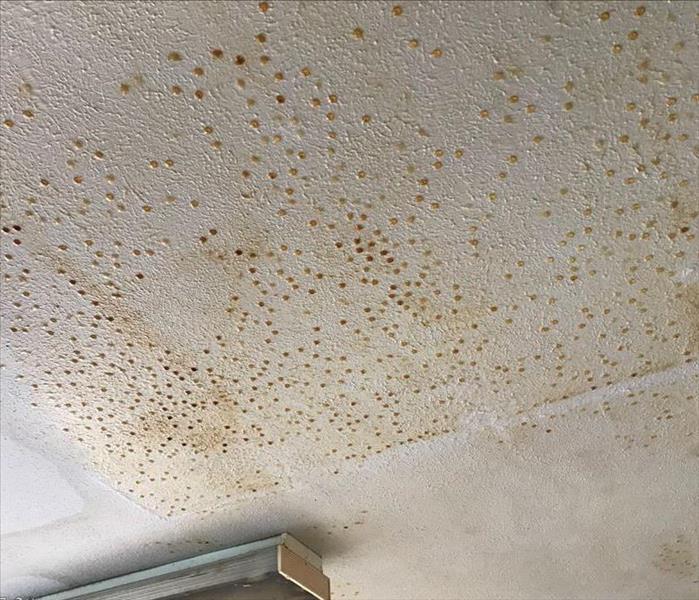 Cigarette smoke and gas heat can leave residues on walls that when wet can run down walls in condensation and look yellowish brown.
Cigarette smoke and gas heat can leave residues on walls that when wet can run down walls in condensation and look yellowish brown.
Bathroom condensation is so annoying, and it's a common problem in most homes. After a shower or bath, water droplets form on the window, walls and mirror when the warm, damp air is cooled by these cold surfaces. Warm air also holds more moisture, which results in heavier condensation.
How do you stop condensation on walls? To stop condensation forming, the bathroom windows should be opened and extractor fans turned on. Try to keep the bathroom door shut as much as possible so the moisture doesn't escape into other parts of your home. Wet surfaces attract moisture, so wipe them down to get rid of the excess damp.
Correspondingly, what causes yellow spots on bathroom walls?
Smoking tar residue shows up on walls and ceilings. If it's just the ceiling, it's likely from using improper paint. That's from smoking on the John. The tar from the smoke deposits on the paint.
How do you fix sweaty walls?
There are a few remedies for high humidity that you can apply to combat this problem.
- Place a dehumidifier in the areas with the most wall condensation.
- Install an exhaust fan in your bathroom.
- Examine the exhaust fan above your stove or range.
- Contact your local professional -
SERVPRO of East Honolulu 808-395-9545
10 Signs of home water damage
5/21/2021 (Permalink)
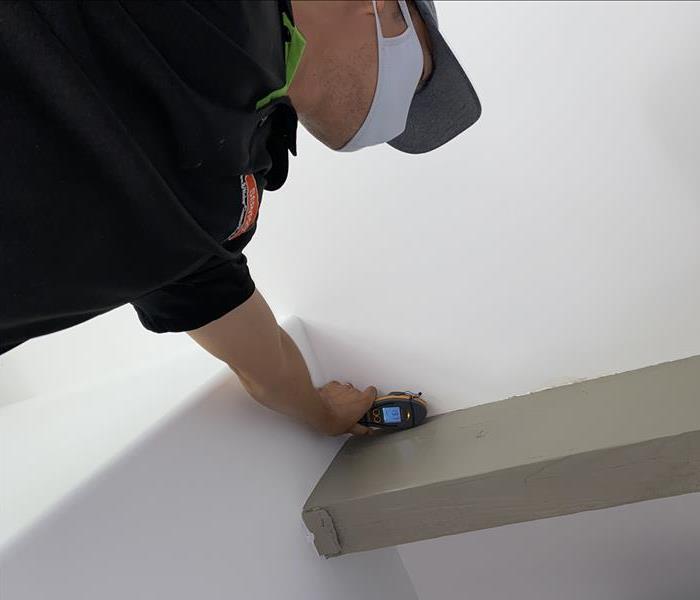 Questionable water damage - call us today at 808-395-9545
Questionable water damage - call us today at 808-395-9545
Sometimes, large water damage problems start out small. Given enough time, a tiny leak can ruin a ceiling or flood a basement. Stay on the lookout for these signs of trouble inside and outside the house.
1. Ring-like stains on ceilings may be caused by loose shingles or flashing problems on the roof.
2. Damp insulation in the attic is another a sign of water leaking through the roof.
3. Blistered paint and peeling paper often indicate water damage in the walls of your home.
4. Warped or loose baseboards are also signs of water damage hiding inside walls.
5. Soft spots in floors, especially around bathtubs, occur when plumbing fixtures fail.
6. Tile or laminated wood floors warp and crack when exposed to moisture for long periods of time.
7. Mold and watermarks under sinks may be the result of faulty supply lines or fixtures.
8. Persistent, musty smells can be signs of hidden water damage in the house.
9. Basement walls can stain and crack due to water accumulation around the foundation.
10. Clogged gutters often spill rain and debris down exterior walls, soaking window and door frames.
ACT FAST WITH FLOOD DAMAGE
5/1/2021 (Permalink)
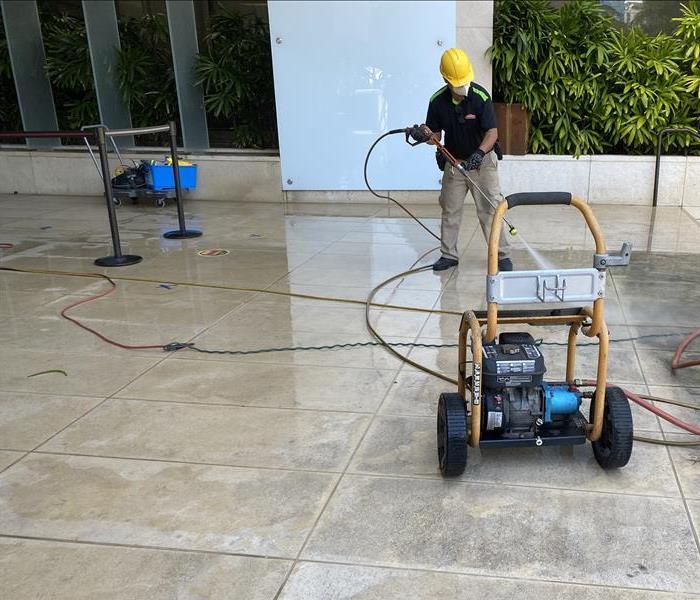 Stop the Water Intrusion & Contact SERVPRO of East Honolulu 808-395-9545
Stop the Water Intrusion & Contact SERVPRO of East Honolulu 808-395-9545
Most people would be surprised at how common water damage is in homes and businesses across the United States. Remember, it’s not always a storm or flood that causes water damage, but more common causes like burst pipes, sewage backup and HVAC leaks.
Water can find its way into the walls, floors, ceilings, furniture, and other belongings, and the degree of damage increases exponentially the longer it is ignored. That is why quickly addressing flood and water damage repair is so important.
So don’t hesitate, instead, have a clear plan in mind if your property faces water damage. Having a reputable restoration company on speed dial is our number one tip.
WHY YOU NEED TO ACT FAST
SECONDARY DAMAGE
The fact is that the longer water damage sits without drying out or repairs being made, the more damage it may cause – known as secondary damage.
COST OF RESTORATION
The longer you wait to deal with flood or water damage restoration, the more expensive the job can become. This is because more of the property will become damaged in the wait, and more extreme restoration services may be needed.
In addition, ignoring water damage for some time may cause problems with your insurance – therefore increasing costs.
MOLD ISSUES
The longer water sits on your carpets, walls, floorboards, ceilings, etc. the higher the chance that your property and contents may be faced with mold and mildew issues.
STEPS TO HANDLE A WATER EMERGENCY
Stop the Water Intrusion & Contact SERVPRO of East Honolulu 808-395-9545
If safe, you want to stop the water damage from escalating by getting to your water valves and shutting them off immediately. Then, contact a professional restoration company to help.
Call Insurance
Insurance companies can help with water damage emergencies. Often they will have the details of reputable restoration companies on hand, and they can help you navigate making a claim. It is also good to call them and find out what steps they require you to take. In the meantime, take photos of the damaged areas and all affected valuables for your records.
Drying Out
If you can, start drying out your home or business within 24 hours. This will help in managing and limiting the growth of mold and mildew. Remove all furniture and rugs and put them out to dry. Bring in fans and dehumidifiers where possible. Call a flood and water damage restoration company for further help, as drywall, insulation, flooring, baseboards, etc. may need to be removed and replaced to prevent mold growth.
Cleanup and Restoration
The truth is that drying out your property after water damage can take a lot of time and effort, as well as specialized equipment. This is another reason why using a reputable flood damage restoration company is a good idea. Calling professionals is the best way to handle any complications and problems that emerge from water damage.
7 MOST COMMON CAUSES OF RESIDENTIAL WATER DAMAGE
4/23/2021 (Permalink)
About 40% of all homeowners have experienced a loss from water damage. It can spread contamination, ruin your paint and damage your wood. The good news is that 93% of all water damage could have been prevented with the right knowledge. How can you protect your home from residential water damage? Here are seven ways to prepare.
1. DAMAGED PIPES
Plumbing systems, especially in older homes, are susceptible to stoppages and damage. To prevent plumbing problems before they start, be on the lookout for cracks, bulges, stains and other signs of moisture on your ceiling or floors. If you spot a leak, it could be a sign that there is damage in other areas as well. Spikes in your water bill could mean you have additional damage to your landscaping, flooring and foundation. Look out for pipes in areas prone to collecting water, such as crawl spaces, cabinets and attics. If you see any signs of water damage, call a plumber right away to avoid larger problems in the future. Be sure to check and insulate your pipes every year before winter begins. Pipes can rupture and freeze within a few hours, soaking your entire house.
2. APPLIANCES
As appliances get older, their pipes can rust and their hoses can weaken. Dishwasher leaks can leave an unwelcome puddle on your kitchen floor. Common causes include worn gaskets, broken doors and clogged drains. It can cause damage to your tile, electrical wiring and paint.
Flooding caused by washing machines is usually caused by leaky hoses. The leak can worsen over time and cause damage to your home. A washing machine valve shutoff kit can prevent the six gallons of water per minute from flooding into your home.
Refrigerators produce a lot of access water that can pool on the bottom of them. Drain lines can also become clogged. If there is a leak in the water supply line that feeds your ice machine, you could come home to a lot of standing water. To prevent your refrigerator from flooding, be sure that it is well insulated. Make sure that you do not move it in and out of its normal position too often, and inspect it regularly for leaks.
3. CLOGGED DRAINS
Bathroom and sink drains can become quickly clogged with dirt, grease, hair and other substances. Pipes can break down, and structural damage is common. If drain clogs are not cleared, problems such as disease, sickness and aggravated health conditions could occur. If left unchecked, clogged drains can cause damage to other places in the home. For example, a clogged toilet can back up into your sink. You may even warp the floorboards and wall support. Small screens can help keep unwanted materials from clogging drains. Pouring boiling water down your drain once a month can help dissolve grease, soap scum and other debris before it clogs your pipes.
4. NATURAL DISASTERS
Hurricanes, breaking dams and snowstorms can all bring excessive water into your home, causing it to flood. Large amounts of water can’t be absorbed by the land, and may overflow into your home. A flood alarm and warning system can help you protect your home against a natural disaster. If you live in a coastal area, be sure to purchase additional flood insurance. Some folks living in flood-prone areas raise their homes on stilts to prepare for floods. Others install foundation vents or sump pumps. You can also grade your lawn away from the house. Make sure you know where the water main is and shut it off when you leave for an extended period of time. This way, you will not come home to any unwanted surprises.
5. HVAC UNITS
Heating, ventilation and air-conditioning systems within your home can cause floods. Be sure to have these systems inspected and cleaned regularly. If you know there is an impending storm, shut off your central air conditioning to prevent damage and risk of electrocution.
6. SUMP PUMP PROBLEMS
If your sump pump stops working, you could have a major flood in your basement. You will then have to deal with mold growth, water removal and bacteria. To keep your sump pump working optimally, always make sure that it is standing upright. Be sure that the vent hole in the discharge pipe is clear. Your outlet pipes should be joined tightly together and drained out at least six feet from your location. If you notice any leaks in your sump pump, call a professional immediately.
7. STRUCTURAL DAMAGE
Moisture dripping through your concrete and crawl spaces can lead to mold and rotting. Check your home regularly for these signs. Cleaning your gutters regularly and maintaining your trees and vegetation will keep unwelcome water from damaging your walls and foundation. You can also install flood protection devices, such as an alarm that goes off when it detects moisture. Make sure your home’s water pressure is not too high. If it is, pipes and hoses can fail under the pressure. You can install a water pressure gauge to help you keep it even. A water pressure regulator can help you in homes where the water pressure cannot be controlled.
PREVENTING RESIDENTIAL WATER DAMAGE
Residential water damage can be caused by natural disasters, clogged drains or damaged pipes. With the right precautions, you likely won’t have to worry about water damage for years to come.
Common Issues that Lead to Toilet Leaks
3/30/2021 (Permalink)
Here at SERVPRO of East Honolulu we have seen all toilet leaks under the sun and the water damage that comes along with them
Toilets are one of the most dependable household appliances-justly so- as they are also the most used and built to endure decades.
Although they are reliable, certain parts of a toilet are more prone to wear and tear. These tend to cause toilet leaks more so than other components.
Here are some common parts/places that usually cause toilet leaks:
1. Base issues
- Loosened closet bolts
- These are the bolts nearest to the floor and are almost underneath the water tank.
- One can often denote it is a bolt issue when your toilet is rocking or feels "loosened" to the base of the foundation.
- Although, tightening the closet bolts will fix your issue of a leaking toilet. If you tighten these bolts too much you can damage your porcelain which is irreplaceable. Cracking your porcelain structure requires a whole new toilet.
- Cracks on a toilet bowl
- Cracks on porcelain automatically means to replace the whole toilet or to seal the cracks with epoxy.
- Hairline fissures can be fixed with epoxy, which can be hazardous to any organisms health and must be done with great care and utmost respect for epoxy instructions.
- Multiple hairline cracks mean that the toilet bowl needs to be replaced. And your toilet will be more prone to breaking randomly and releasing its contents.
- Broken Wax Seal
- Wax seals can be often tricky as they are not seen superficially at first. Wax seals maintains that the water going in and out of the toilet every time one flushes stays in the pipes. When they are broken or worn down, they slowly release water and warp your flooring.
- Wax seals can crumble, dry out, or flat out fail, this can happen over time or even prematurely. Also, a wobbly toilet denotes occasionally a broken wax seal/ring.
- This can be replaceable and an easy fix, yet they can be the most dangerous. As they actively participate in facilitating the efficiency of water and waste to the pipelines; they can cause the most damage to one's own property and can even cause rotting because of the frequent leaking water.
2. Continuous Water Running the in the Septic Tank
- There are many reasons as to why there would be running water in a septic tank, more so than needed to be efficient. This can also increase your water bill as there is a continuous flow of water going on in your toilet
- Water level in the tank is created by an adjustable float that produces the strength of the water pressure in flushes. Floats that are set too low make weak flushes, and ones set too high can cause water to spill the overflow tube and will not properly stop the fill valve from shutting off.
- Once the float is set to the proper level for your toilet, make sure that the chain attached is untangled so the flapper can close properly. If water is still running after regulating the float and the chain, one needs to replace the flapper altogether.
3. Shut-Off Valve Leaks
- It is very rare for one to use the shut-off valve, over repeat usage or usually over time the washer inside the valve can harden with the deposit of minerals from water overtime. Changing out the washer can be imperative to the continual usage of your toilet.
- Another way that shut-off valve leaks from a nut that becomes loosened overtime. Tightening the packing nut, usually stops the continual leaks.
It is imperative to understand the toilet parts and the integral usages of them, acknowledging the more frail components will save you money and time.
And if there is water damage, and one hasn't caught it in time- as some of these leaks can exponentially increase in damage as the days pass, and it goes unnoticed...
SERVPRO of East Honolulu is here to help, with water extraction, removal of damaged infrastructure, and the overall repair job.
Water Damage on Your Ceiling, Now What?
12/20/2020 (Permalink)
Water damage on your ceiling can happen to anyone and everyone, it may be from clogged pipes, faulty toilets, overrun showers or your neighbors upstairs. Whatever the cause, business owners end up facing the mess of sewer damage, an absolute physical, emotional, and financial drain. It's even harder when that break happens on the second story, allowing the polluted fluid to seep down below, ruining not just one floor but two. If this is the case, consider the following to get the building back to normal.
1. Have a Thorough Inspection
First, contact SERVPRO of East Honolulu. Our expert team have specialized equipment and knowledge. When they arrive on scene, our staff should begin to survey the damage, section off the impacted zones, and prepare a plan to sanitize your space or take care of the damage.
2. Take Care of Soaked Material
Unfortunately, most water damaged goods have to be cleaned heavy duty style. It's not something that is simply dried up due to the smell of most water damages. Our crew will begin removing the soaked flooring as well as the affected portions of the ceiling. If the liquid penetrated through, it may have harmed the downstairs. If that is the case, they could begin tearing out items from here as well.
3. Restore the Rooms
The flooded toilet and other fixtures may be replaced with newer items. The spaces are dried with dehumidifiers and then sprayed with antimicrobial spray. At this point, one of our contractors or your insurance's contractors begin construction, patching, painting, and replacing anything lost from the flooding. By the end, both floors should look like they did before.
Sometimes sewer damage is unavoidable. While you can't stop it, you can fix it. Seek the aid of experts who can lead and advise.
We do our part so everyone else can do theirs, and just like that it looks "Like it never even happened."
That Drip
11/6/2020 (Permalink)
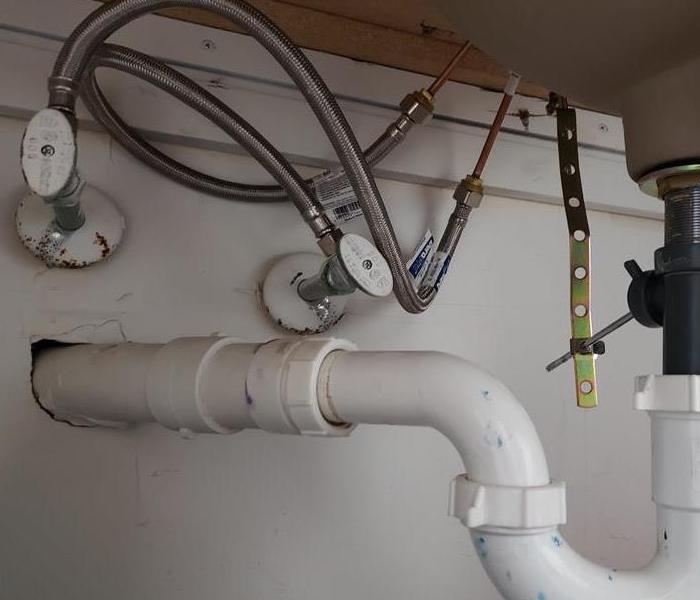 Make sure to check your everyday appliances for wear and tear to ensure that you don't need to call us anytime soon :)
Make sure to check your everyday appliances for wear and tear to ensure that you don't need to call us anytime soon :)
Nowadays, one can hear "drip" as a modern convention to mean something like " gold chains" or "clout"- social power. No, here at SERVPRO of East Honolulu the "drip" has and will always be known as a bad idea, entailing water damage. Our "drips" can happen anywhere, subtle leaking from your toilet or any of your appliances using water.
Drips can happen from storms or natural causes, or the inefficacy of one's machines. Drips can be costly, and lead to most water damage cases we see today.
Look for water damage in the following appliances:
- Behind the tub casing. The caulk that seals tubs slowly wears away through usage, leaving cracks for not just pests and mold to harbor but also water. This is one of the biggest reasons why mold is an issue in restrooms; the cause being water stagnancy from caulk holes.
- At roof intersections. The seals around common roof intersections, exhaust fans, are also not made for surplus amounts of water. Water occasionally deposits at these intersections and once set will cause issues for homeowners and business owners alike.
Under a sink can often hide small drips, which can turn into big water damage aiding to mold.
Behind drywall. Drywall is made to hide the structure of the home, but it can also hide water damage to that structure—especially following floods or burst pipes elsewhere in the home.
At roof intersections. The seals around common roof intersections such as chimneys and exhaust fans are designed to keep out water but are not designed to last forever.
Inside an AC unit. The line that draining the condensation from an air conditioning unit can become backed up that sends water inside of the unit instead causing malfunctions.
Beneath appliances. Washing machines and dishwashers pump a large volume of water into and out of the house and can cause hidden leaks that lead to costly repairs if not thoroughly checked.
Behind exterior faucets. A house can easily hide a leak from an exterior faucet, which can occur when its bond to the water pipe malfunctions ending in water bursts.
Watch Out for Flood Water!
11/5/2020 (Permalink)
Water damage could happen to anyone, us at SERVPRO of East Honolulu have almost seen it all. A running facet, or shower, water damage from the apartment above, leaks and more. But, the most dangerous thing to come out of water damage is the water itself.
Please be careful when assessing your water damage!
And, make sure you know where the water is coming from before delving in to the cleaning up.
If the water is brown or dirty, do not touch it. Wait until professionals come, unclear water means the water is contaminated with something. Although it can be something as simple as dirt, it can be as deadly as pathogens. This type of contaminated water can be from a sewage system, leaky pipes allowing contaminates into the water before bursting...etc.
Here are some things to be mindful of when dealing with said contaminated water, or water in general:
-sewage particles
- viruses
-toxic chemicals
-bacteria
-microbes
We know of the stress and anxiety that occurs when a leak or water enters your home, know that there are ways to prevent in the future, and professionals who are a phone call away.
SERVPRO of East Honolulu is available 24/7, 365 to make the cleaning and restoring process for you simple and efficient.
The Three Types of Water Damage
10/1/2020 (Permalink)
There are three types of water damage that we assess certain damages as. To make sure that we get the best profile for your damage, and clean up we categorize where the water is from. This gives us a good idea of how it will affect your walls, floors, or ceiling; this also tells us if there is extra disinfecting needed. Our experts can tell if there is more beneath your damage and if there is an underlying cause before anyone else!
SERVPRO of East Honolulu can guarantee a procedural, and professional process for you. Here are the categories:
1. Category 1, water that does not seem to threaten life such as humans or pets is deemed a category 1 or, "clean water". This can be something like an overflow of a sink or tub, or a faucet failure.
Our experts can clean swiftly and effortlessly. This type of water needs a good drying with our fans and de-humidifier and a sanitize. This type of water is the most simple water because there are not contaminates in it. These type of jobs can take 1-10 days.
2. Category 2, has some type of containment to it, like an in between of category 1 and 3. This is at the experts digression, of a significant degree of containment. This could be physical, biological or chemical of origin that can cause sickness or discomfort if consumed by a life source. This could be from a toilet, or water from a washing machine/ dishwasher.
This type of category takes a little bit longer to clean as there is more of a sanitizing and disinfecting that needs to be done. There also needs to be a demolition if there are surfaces that are damaged and can not be washed or cleaned effectively. Soft goods can be washed or discarded.
3. Category 3 means that the water is grossly contaminated and is extremely unsanitary. This can be sea water, sewage water, a toilet trap, even category 2 still-water can turn into category 3 water. This can also be considered "black water."
Our experts know of the dangers of "cat 3" and need to "demo" as soon as possible. This type of water has extreme after effects and needs to be cleaned to lessen the damage. Affected dry wall, carpeting, flooring besides concrete and heavy wood need to be removed. Dry wall is not privy to cleaning and most porous substances need to be removed, to the exception of heavy duty wood which can withstand the cleaning needed for cat 3 messes. Our team also needs to heavily clean the areas before an owner or insurance can place in new flooring or dry wall. If there are soft substances they can be cleaned in our industrial cleaner or replaced.
When we do an assessment of your damage it is imperative to know what type of category your water is in, to make the job that much easier and for your safety. Here at SERVPRO of East Honolulu your ease is important but even more so if your health and safety. We do our jobs to completion with your health in mind so you can rest easy!
Living with Water Damage and Repairs
10/1/2020 (Permalink)
Here at SERVPRO of East Honolulu we know how stressful water damage can be. It seems like it is an additional load after everything else going on in our customer's lives.
It can even throw you off if you come home to a big water breakage or mess, but here at SERVPRO of East Honolulu we are here to help. We have innovative tools and a qualified team to quickly clean it up.
But, while they are doing their job it can be hard living with the machines and the repairs.
For us, it is our goal to make sure that it looks "Like it never even happened." A SERVPRO promise and a strive for excellency. While we are cleaning we know that it can be a stressor. And we try to accommodate as much as possible. Like cleaning quadrants or making various containments to only interrupt segments of your life.
We also only do demolitions if it is absolutely necessary, we try to do our job to maintain the integrity of the original house for less hassle and money. And when we do a demolition the process is generally very quick and efficient so an a contractor can do their job as quickly as possible.
Here at SERVPRO of East Honolulu we also strive to keep our servicing well within a week, so you can keep your life running smoothly and we can continue our quick and efficient track record.
We try as hard as we can to make sure that we do our job smoothly so you can go on:
"Like it never even happened."
Saving Money by Being Cautious
9/15/2020 (Permalink)
Most people don't mind a leaky faucet or pipe, as long as it is only a few drops there is nothing to worry about... right?
Actually, a leaky faucet can cause up to 7 gallons of water lost in one day.
Not only this, if there is a significant flow of water there can be at least 30 gallons of lost water. There also many programs that actually calculate how much water could be lost based on your estimations!
The problem with leaky/ faulty water pipes and faucets mean that there are long term problems with your materials!
Once a leak starts, the longer that the problem is not fixed the more the pipe endures water damage, and also your house.
Approximately,
-15,140 drips of water makes one gallon
- 4,000 drips make a whole liter
That is a whole gallon or liter wasted because of a dripping faucet.
It is about $20-60 to fix a leaky pipe or faucet if you call a professional, which seems like a lot money. But, in comparison a leaky pipe or faucet can cost anywhere from $100-$600 a month!
Make sure if you have a leaky pipe, or faucet or anything that is using unnecessary amounts of water you fix it immediately. Not only will this save money, but it will also conserve necessary water for your ohana or business.
But, wait there is more...
running toilets!
Running toilets can also be a huge money sucker! A running toilet on average wastes about 200 gallons in a eight hour time window. This means that a running toilet can cost about:
$75-$150 a month
And if your problems go unchecked, this can cause long term damage...
That's when you'll have to call us
We have seen faulty pipes break because of a simple issue, and from that extensive water damage to your business or home.
This can come in all shapes in sizes like damage to your dry wall, odor because of a water clean up, or even erosion if the problem has been occurring for a long and continuous time.
Not only this, but when you think about it...
Where does this water go? It isn't being consumer by you, or your constitutes.
----------> well it is going to your local water company, the only issue is that if there are enough leakages in the neighborhood, or community; that is a significant amount of water. Being additionally treated that has not been used, this may increase the general price of water. Many water treatment companies have also stated that leakages are one of the main reasons why water is being inflated.
So check on your pipes, take care of your running toilet, and leaky faucets/pipes. At the end of the day it will be easier for you, and you won't have to call us :)
Reasons Why Your Pipes Burst
6/30/2020 (Permalink)
Our team of SERVPRO of East Honolulu have seen multiple types of problems that cause pipes to burst. Here are so reasons as to why your pipes burst, but don't worry! We are on call 24/7 for your convenience and safety.
- tree root encroachment
If you have trees growing near your house it could be a problem later on for your water pipes. Over time tree roots continue to grow and reach out. Sometimes this can cause issues to your foundation and pipes. Most pipes are not strong enough to withstand the pressure and power of strong tree roots.
-corrosion
Over the years, especially with steel, your pipes undergo a lot of water damage due to heavy usages. Copper and plastic pipes can stop this water corrosion, but for those pipes that aren't can burst from this type of damage. This starts by simple corrosion which in turn makes the pipes narrower and narrower until the pressure of the water is greater than that of the pipes. This in turn causes pipes to burst.
-soil shifting
When one is doing construction work near a water pipe this can cause the soil to shift. When one displaces the soil that the pipe rests on this causes strain on the pipe. Also putting strenuous amounts of soil on top of the pipe can cause a strain, the pressure of the water with the addition of the soil may cause your pipes to burst.
-high water pressure
When a water pipe exceeds a certain degree of pressure it can cause a pipe to burst. Make sure you know what type of pipe you have and that the pressure is at the appropriate setting to not have bursting pipes.
-clogs
There are many reasons to have clogs in your water pipes; this can be bathroom products, food, oil buildup, hair... etc. When there is a clog there is a buildup of pressure within the pipe. This can cause an extreme strain on the pipe that it can't withstand therefore cracking. The pressure will be too great and in return the pipe bursts. So make sure you are aware of what you are throwing down your drains.
-rusty pipes
The best pipes for the lack of corrosion are plastic and copper pipes, which can withstand water corrosion. When metal pipes are not frequently replaced the rust growth can cause pipes to burst.
Water Damage on Your Ceiling, Now What?
6/18/2020 (Permalink)
Water damage on your ceiling can happen to anyone and everyone, it may be from clogged pipes, faulty toilets, overrun showers or your neighbors upstairs. Whatever the cause, business owners end up facing the mess of sewer damage, an absolute physical, emotional, and financial drain. It's even harder when that break happens on the second story, allowing the polluted fluid to seep down below, ruining not just one floor but two. If this is the case, consider the following to get the building back to normal.
1. Have a Thorough Inspection
First, contact SERVPRO of East Honolulu. Our expert team have specialized equipment and knowledge. When they arrive on scene, our staff should begin to survey the damage, section off the impacted zones, and prepare a plan to sanitize your space or take care of the damage.
2. Take Care of Soaked Material
Unfortunately, most water damaged goods have to be cleaned heavy duty style. It's not something that is simply dried up due to the smell of most water damages. Our crew will begin removing the soaked flooring as well as the affected portions of the ceiling. If the liquid penetrated through, it may have harmed the downstairs. If that is the case, they could begin tearing out items from here as well.
3. Restore the Rooms
The flooded toilet and other fixtures may be replaced with newer items. The spaces are dried with dehumidifiers and then sprayed with antimicrobial spray. At this point, one of our contractors or your insurance's contractors begin construction, patching, painting, and replacing anything lost from the flooding. By the end, both floors should look like they did before.
Sometimes sewer damage is unavoidable. While you can't stop it, you can fix it. Seek the aid of experts who can lead and advise.
We do our part so everyone else can do theirs, and just like that it looks "Like it never even happened."
What is the Class of Your Water Damage?
6/18/2020 (Permalink)
Not only does SERVPRO of East Honolulu use categories to define the water quality, we also you a class for classification of water absorption and evaporation load.
Before understanding the class themselves there are a few definitions to knock out.
Definitions:
Porous Materials- carpet, gypsum board, fiber-fill insulation, concrete masonry unit, textiles
Low Evaporation Materials- Plaster, Wood, Concrete, Masonry
Low Evaporation Assemblies- Multi-layer wallboard, multi-layer sub-floors, gym floors, or
other complex built-up assemblies
The Water Classes:
Class 1: The least amount of water absorption and evaporation load
- water intrusion (where it's wet) area contains less than 5% of porous materials. And low evaporation materials/assemblies have absorbed minimal moisture.
- meaning, Only part if a room or area is wet or larger areas containing materials that have absorbed minimal moisture. Little or no wet carpet and/or pad is present.
Class 2: Significant amount of water absorption and evaporation load
- water intrusion area contains 5%-40% of porous material (this is encompassing the floor, wall, and ceiling surface). And low evaporation materials/assemblies have absorbed minimal moisture.
- meaning, An entire room or more is affected. Carpet and pad may be wet. Water has wicked up walls less than 24 inches. There is significant moisture remaining in structural materials.
Class 3: Greatest amount of water absorption and evaporation load
- Water intrusion area is made of more than 40% of porous materials. And low evaporation materials/assemblies have absorbed minimal moisture.
- meaning, Fully involved. Water may have come from overhead. Ceilings, walls, insulation, carpet, pad, and sub floor in virtually the entire area are saturated.
Class 4: Deeply held or bound water
- Water intrusion area is most of low evaporation materials/assemblies. This means that there will be a need for heavy duty drying equipment that will vary for each humidity level
- meaning, Specialty drying situations - Wet materials with very low permanence/porosity i.e hardwood, concrete, brick. Typically, there are deep pockets of saturation, which require very low specific humidity.
Flash Floods in Hawai'i: How to Prepare For Them
6/6/2020 (Permalink)
Residents of Hawai'i are all too familiar to the flash flood warnings on the television or radio. It starts with the loud beeping and the calming voice of a government official and ends with warnings for the road or the beach. Most even experience the heavy rainfall when they are driving, but although we are use to flash floods there still needs to be caution.
We at SERVPRO of East Honolulu have seen the damages of a heavy rainfall or flash flood. Hawai'i averages about 11 flash floods per year and they mostly happen between April and October. Here are some things to keep in mind, when we have flash flood warnings:
- Flash Flood Advisories mean that it is a precursor to Floods, meaning, flooding is possible but not imminent.
- make sure your gutters are clean! When gutters are clogged it backs up your system. Make sure you clear out debris so your excess water can flow smoothly and help prevent water damage. This should be done at least two times a year to ensure the clearest way for water to vacate properly.
- check on your roof! Many homeowners don't even know they will fall victim to a flash flood until it happens if they aren't checking their roof. Check on the life of your roof, if there is a worn shingle, a missing one, or peeled sealants this can tear up your whole roof. Serious water damage can occur from simple fixes if not carefully watched. You should check your roof once a year, make sure that everything is ready to go for your Ohana's safety.
- do you have a proper drainage system for your house? Even if the foundation of your house is of cinder block or concrete it can still fall victim to water damage if there is no drainage system. Down spout and gutters are only half the equation of your house drainage system, the other is the subsurface system. This entails your foundation area and leaking or a high amount of water buildup can be mitigated by landscaping and drainage systems curtailed to your home and terrain.
- low risk does not mean no risk, homeowners and business owners alike should be careful regardless of a low risk. Make sure you know what you are privy to whether it be soil erosion, high surf, dam failure, or excess water. We recommend that our customers and community find insurance that covers these types of damage for your convenience during an emergency.
As we are heading out of our flooding season, we just want to make our customers aware of the possibility for a safer tomorrow and prepare for the next one!
Heavy Rainfall Can Also Cause Water Damage
5/9/2020 (Permalink)
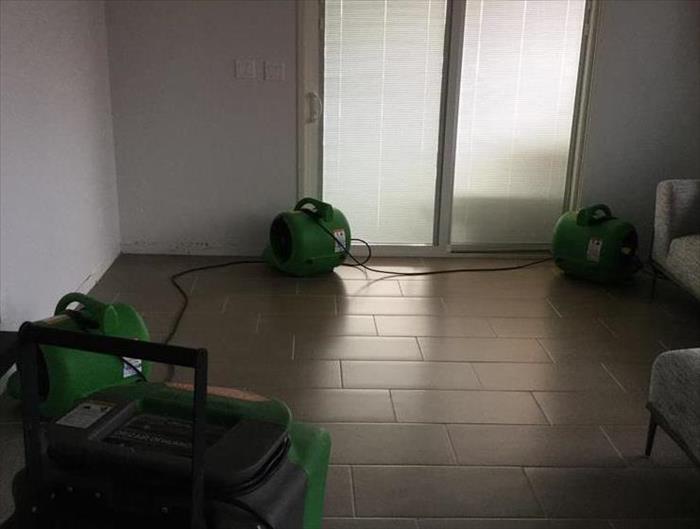 If you’ve experienced water damage to your home, we are here to help. You can call us 24/7 to have our trained technicians respond quickly
If you’ve experienced water damage to your home, we are here to help. You can call us 24/7 to have our trained technicians respond quickly
What comes to mind when people think of water damage is typically dramatic occurrences of floods or plumbing problems, but everyday events such as heavy, consistent rainfall can also cause issues.
Heavy rains can quickly exploit any vulnerabilities in a home’s weatherproofing and lead to water damage. Here is where we often see damage when we respond to water calls:
Problems That Can Be Caused by Heavy RainfallBackup of clogged gutters. Debris can build up in gutters quickly, which is why they are recommended to be cleaned at least twice a year. If they are not, the water can quickly begin to build up in the gutters during heavy rainfall and can seep into the roofline and cause damages.
Leaks around windows and doors. Microscopic cracks around doors and windows can easily let heavy rains in to start causing damage. Adding weatherstripping measures is an easy, effective way to prevent this from occurring around your home’s external openings.
Poor drainage around the foundation. If heavy rain leads to water building up around your foundation, it is wise to install landscaping or other drainage systems that can help to move this water away. Standing water can seep into the home’s foundation and cause serious damages otherwise.
Leaks in and around the roof. Roof leaks can be sneaky, so it is best to look for signs of them and treat them before they cause issues. Missing shingles or other vulnerabilities can give heavy rains the in they need to cause damages, so doing repairs early is recommended.
Malfunctioning of a sump pump system. A sump pump system is a fantastic tool for preventing water damage to basements and crawl spaces, but they can develop issues that allow damages. Regular sump pump maintenance is the best preventive treatment for this, so it is what we advise.
Leaks around chimneys and skylights. As homes age, their seals can begin to fail, and the seals around chimneys and skylights are no exception. Have your roof regularly checked for vulnerabilities with these seals to prevent heavy rains from seeping in around these features.
If you’ve experienced water damage to your home, we are here to help. You can call us 24⁄7 to have our trained technicians respond quickly and begin your restoration.
Our 6-Step Water Damage Restoration Routine
4/25/2020 (Permalink)
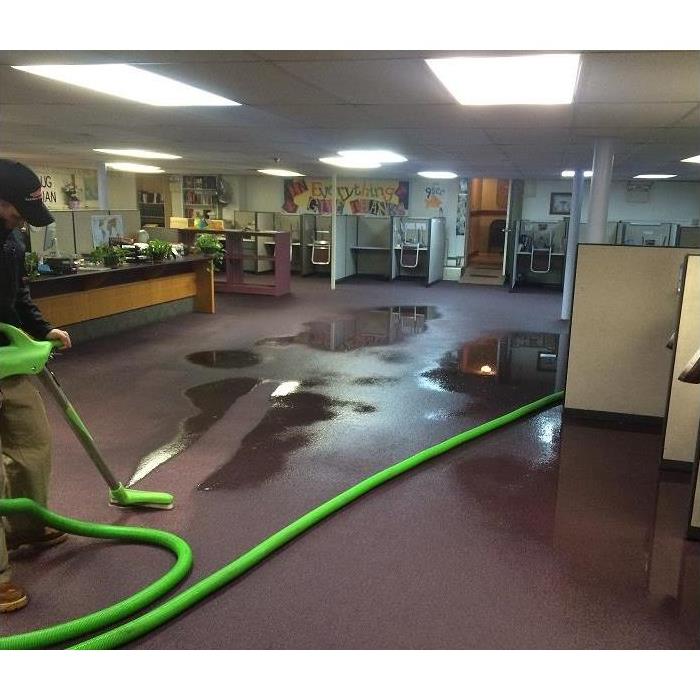 Finding out that water damage has impacted your home may be overwhelming, but quickly taking action is recommended when you do.
Finding out that water damage has impacted your home may be overwhelming, but quickly taking action is recommended when you do.
Finding out that water damage has impacted your home may be overwhelming, but quickly taking action is recommended when you do. For this reason, we are here 24⁄7 to answer your call for help and set our six-step water damage restoration routine in motion.
Here’s how it works:
6 Steps to Water Damage Restoration
1. Initial Emergency Contact
With our emergency contact line, you can reach us no matter when you discover water damage to your home or office. We will gather information regarding the severity of the damage so we can determine how to facilitate our response and get to you as quickly as we are able to.
2. Inspection and Damage Assessment
After we get to your location, our trained technicians will check for any safety issues that are present and stop the flow of water, if applicable. They will then do a complete inspection in order to make a restoration plan to review with you before the work begins.
3. Moisture Extraction
Quickly moving to the moisture extraction is an integral part of preventing further damage, so we will begin pumping out gallons of water as fast as we are able to. We can also help you remove your belongings from the area if you will be staying elsewhere during the restoration process.
4. Dehumidifying and Drying
Following the extraction of the standing water, we will bring in dehumidifiers and industrial-grade drying equipment to remove moisture from the pores of impacted surfaces. Not only will this prevent them from deteriorating, but it will also guard against future problems with mold growth, which can occur after improper restoration.
5. Cleaning and Repair
For any object that has been exposed to water damage, cleaning is vital. Cleaning will ensure that these items do not become contaminated after water damage is allowed to fester on their surfaces, and will keep them from developing odors as well.
6. Restoration
We proudly offer a full and complete restoration service, which means we can even handle construction issues that may arise due to water damage. We can repair and replace structural elements of your home and lay new carpet or make other cosmetic updates to truly restore your building to its pre-damage condition.
If your home has been water-damaged, you can count on us to help. Call us 24⁄7 to get the process started.
Appliances That Commonly Cause Water Leaks
1/4/2020 (Permalink)
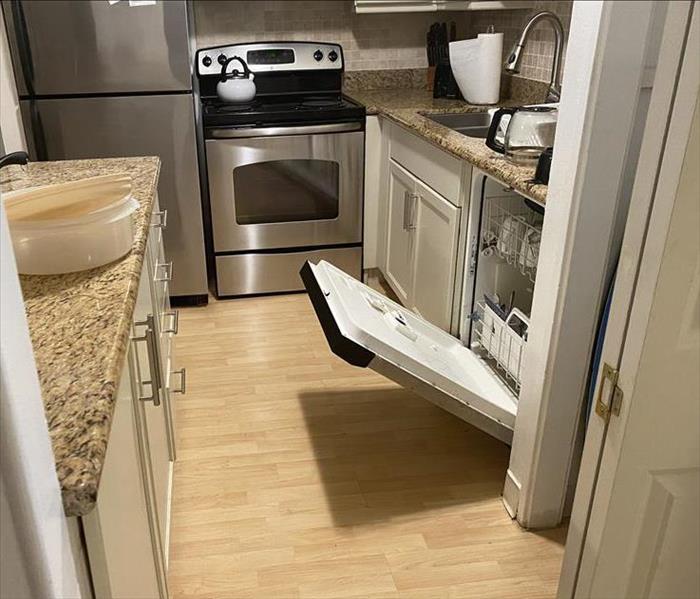 Water damage caused by an overflowed dishwasher
Water damage caused by an overflowed dishwasher
There are an alarming number of situations that can cause water damage to homes—weather incidents, flooding and burst pipes often come to mind.
However, the source can also be from things we utilize every day, such as appliances that require water to operate. Prevention is key to stopping small, sneaky leaks from becoming a big problem, which is why we put together a guide of what appliances to watch out for and how to check them for drips.
What Appliances to Check for Water Damage
Hot Water Heater
Though hot water heaters can typically last as many as 15 years, they can begin leaking water much sooner due to faulty pipes and seals. Check regularly to avoid this from catching you by surprise, and be sure you replace it based on the manufacturer’s recommended time frame.
Refrigerator
The ice maker inside of the refrigerator pulls water in to manufacture the ice, but the tubing it uses to do so can often falter. Add that to the fact that refrigerators are seldom moved, and you have a recipe for water damage to get out of hand before you even realize it has begun. Simply pulling the fridge away from the wall and checking for drips regularly is enough to prevent this from becoming an issue that gets out of hand.
Dishwasher
A dishwasher can be another common culprit for secluded damage because of how they are typically built into cabinets. Pulling them out of their cubby often is wise, especially if you have an older model. It is not uncommon for homeowners’ insurance policies to not cover water damage from older appliances, so this is extra important to note.
Washing Machine
Washing machine leaks are such a common problem that it is recommended to check their hoses as frequently as once a month to guard against wear and tear. Even with regular checks, exercise caution by replacing these hoses every five years regardless of if they appear worn.
Air Conditioner
All air conditioning units manufacture condensation as part of their operations, but if there is an issue with their draining capabilities, issues can arise. The best way to prevent this is by following your manufacturer’s instructions regarding inspections and maintenance, as well as doing your own visual checks to ensure there is no water out of place in and around the unit.
If your home has been impacted by water damage or you’d like to put a plan in place in case it happens to you, contact us to learn how we can help.
Water Damage Restoration: What to Do When Your House is Flooded
11/16/2019 (Permalink)
Flood Preparedness: How to Prepare for a Flood Disaster
If you haven't been affected by storm damage, you should still prepare in case of future disasters. Here are some simple steps that businesses and homeowners can take to reduce the impact of natural disasters:
- Check your insurance policy – Flood damage is not covered by standard homeowners or renters insurance policies. In some high-risk flood areas, home and business owners may be required by law to carry flood insurance. To learn more about your state's requirements check with your Insurance Commissioner.
- Take pictures/video of your business or home as a point of reference in the event of an emergency.
- Back up critical digital files on a portable external hard drive and store it away from the office.
- Properly anchor fuel and propane tanks, so they don't float away in case of flooding. Also, ensure you keep your fuel levels full ahead of storms.
- Have copies of your insurance policies on hand and have an electronic version available.
- Collect family photos and other mementos in a centralized and easily accessible area, preferably in a watertight container.
- Keep medicines together in a waterproof container.
- Prepare an emergency kit with a change of clothes, weather appropriate footwear, flashlight, water, and battery or crank operated radio to monitor the weather without electricity.
- Discuss your emergency plan with your family. Designate a "safe place" inside if you have to take shelter and a meeting place outside in case you have to evacuate.
Ways for Business Owners to Prepare for Floods | SERVPRO® of East Honolulu
10/26/2019 (Permalink)
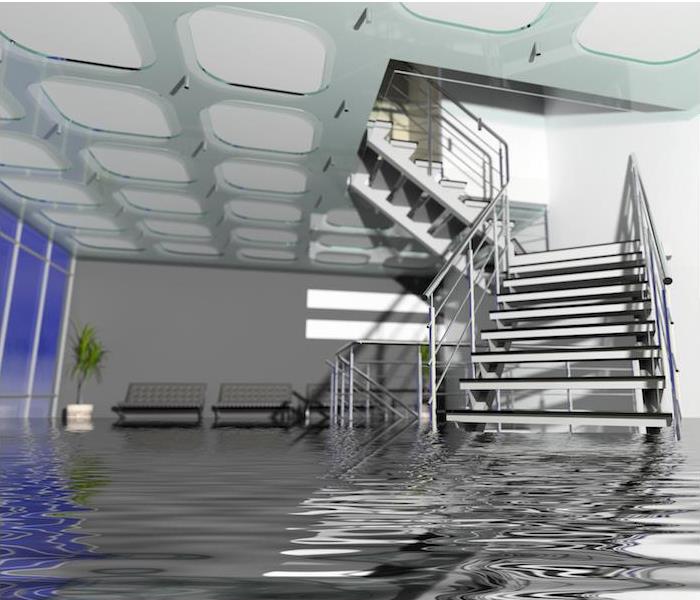 If you've experienced a flood, we are always here to help. Call us 24/7 to get our team of professionals to your business quickly so you can get back
If you've experienced a flood, we are always here to help. Call us 24/7 to get our team of professionals to your business quickly so you can get back
There are many things that business owners must plan for regarding their livelihood, but all too often, floods are left off that list. For those outside of a known floodplain, planning for one can seem like a waste of time—but with 90% of natural disasters involving floods, it is not unheard of for areas not historically prone to flooding to be affected.
Because business owners also have a degree of liability, planning for a flood is a great way to keep your employees safe and ensure your business is well-poised to reopen after the waters retreat. Practicing preparedness provides valuable peace of mind and can have a big impact on the future of your business.
<h3to-do-to-prepare">What to Do to Prepare
There are many ways to practice flood preparedness, but some of the most important are:
- Locating your business on the FEMA Flood Map to determine your risk levels
- Keeping copies of important documents stored away from the business in a secure, waterproof place
- Training employees on your emergency plan in order to educate them on what to do
- Creating evacuation routes that are well thought out and making sure everyone is aware of them
- Inquiring about your insurance coverage and whether adding flood insurance might be a wise choice
- Storing emergency rations and first-aid supplies in case a situation arises where you are stuck
- Elevating valuables so they are not ruined by low-height floods
<h3the-right-documents">Preserving the Right Documents
By having copies of important documents on hand, business owners can ensure they are set up to reopen even if the originals were destroyed. Some of the best ones to preserve are:
- The continuity plan for the business
- Details on how to contact parties essential to the business, such as staff and vendors
- Details on how to file an insurance claim and contact your agent
- Instructions for accessing backed-up digital files
- Banking history, deed or lease information and any financial documents that might be helpful
If your business has experienced a flood, we are always here to help. Call us 24⁄7 to get our team of professionals to your business quickly so you can get back on track.
Tub Causes Flood Damage in Your Home
9/6/2019 (Permalink)
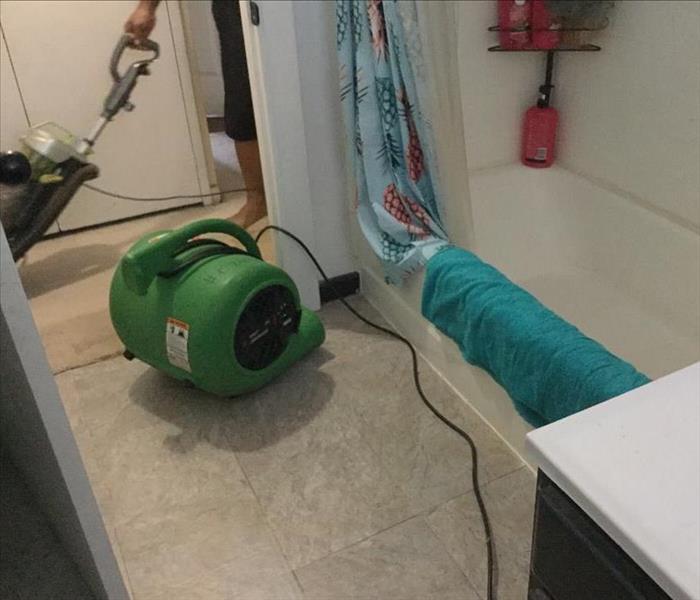 Faulty leak caused water damaged a honolulu home
Faulty leak caused water damaged a honolulu home
Accidents can happen to anyone, although some create more problems and have higher financial costs than other accidents. A forgotten and soon overflowing tub is one of the more expensive problems that happen in life. Left for hours, flooding can become extensive. Total costs increase the longer a homeowner waits before calling for restorative experts like SERVPRO to begin mitigation work. Waiting to call for experts to restore a home after flood damage first happens can not only become more expensive but also become much more damaging to areas that were originally untouched by the water. These places that suffer later are a result of the increased moisture within the home. Even though it may not seem possible, moisture easily travels from one vicinity inside a home to another in a search for equilibrium. Dryer areas experience an increase in humidity, and this can affect stored photo albums, clothing, and other fragile items, belongings, and accessories in closets, and so many other locations inside a home.
Our goal is to restore the humidity level inside your home after a flooding event. We begin by removing as much of the water as we can extract with different pieces of equipment. When things feel dry, we start with the removal of the extra moisture. Dehumidifiers, vast and powerful air blowers, and even heaters when conditions warrant their usefulness help remove moisture from materials inside your home quickly, minimizing damage. Carpets and flooring such as hardwood and parquet can suffer greatly when there is a delay in these efforts. The implementation of heating mats increases the rate of evaporation from these horizontal surfaces so that the dehumidifiers easily remove the moisture. This process can help save carpets and floors that were damaged by clean water. Even with structural damage halted and kept at a low level, any flooding can create a stagnant odor that is present in almost every area of the home. Whenever this occurs, we use special deodorization techniques that effectively eliminate the scent.
For catastrophes that occur inside your home, do not hesitate to call us. We are SERVPRO of East Honolulu and answer our phone at any hour and every day of the year. Our number is 808-395-9545. We want to assist you and your family by restoring your home so that it is “Like it never even happened.”
Cleaning up after a flood
9/7/2018 (Permalink)
When your house floods, the water can wreak havoc on the structure of the house, your personal belongings, and the health of the inside environment. Flood waters contain many contaminants and lots of mud. High dollar items can get ruined all at once, even with just an inch of water, for example: carpeting, wallboard, appliances, and furniture. A more severe storm or deeper flood may add damage to even more expensive systems, like: ducts, the heater and air conditioner, roofing, private sewage and well systems, utilities, and the foundation.
After a flood, cleaning up is a long and hard process. Here is a list of common techniques for sanitizing and cleaning flooded items:
- First things first: call your insurance agent. If your insurance covers the damage, your agent will tell you when an adjuster will contact you. List damage and take photos.
CALL SERVPRO OF EAST HONOLULU 808-395-9545. Our staff is highly trained in property damage restoration.
- Take furniture, rugs, bedding and clothing outside to dry as soon as possible. Use an air conditioner or dehumidifier to remove moisture or open at least two windows to ventilate with outdoor air. Use fans to circulate air in the house. If mold and mildew have already developed, brush off items outdoors to prevent scattering spores in the house. Vacuum floors, ceilings and walls to remove mildew, then wash with disinfectant. Wear a two-strap protective mask to prevent breathing mold spores.
- Mattresses should be thrown away.
- Upholstered furniture soaks up contaminants from floodwaters and should be cleaned only by a professional.
- Wood veneered furniture is usually not worth the cost and effort of repair.
Solid wood furniture can usually be restored, unless damage is severe. - Toys and stuffed animals may have to be thrown away if they've been contaminated by floodwaters.
- Photographs, books and important papers can be frozen and cleaned later. They should be dried carefully and slowly. Wash the mud off and store the articles in plastic bags and put them in a frost-free freezer to protect from mildew and further damage until you have time to thaw and clean them or take them to a professional.
You can avoid the hassle of the clean up by calling SERVPRO OF EAST HONOLULU. We will get the job done like it never even happened.
How to Help Prevent Water Damage
4/13/2018 (Permalink)
It's important to check household appliances regularly. The simple steps below can help you protect your home from the most common causes of water damage:
- First, know where the main water supply is located in case of emergency.
- If you will be away from home for an extended period, shut off the water supply and drain the pipes. If your home is protected by a fire sprinkler system, do not turn off the water to this system.
- Check the drain lines annually and clean them if they are clogged.
- Inspect water heaters, showers, tubs, toilets, sinks and dishwashers annually, and have them repaired if there are any signs of leaks or corrosion. When possible, install water heaters in areas with floor drains to minimize damage if leaks should occur.
- Check caulking around showers, bathtubs, sinks and toilet bases, and make repairs as needed.
- If your refrigerator has an ice machine or water dispenser, the hose between the wall and the refrigerator should be made of braided copper, which has greater cracking and corrosion resistance.
- Check pipes for cracks and leaks. Have pipe damage fixed immediately to prevent more costly repairs in the future.
- Check appliance hoses and plumbing fittings for breakage, crimping or bending.
Overflowed Toilet
6/26/2017 (Permalink)
An overflowing toilet presents an immediate problem that you must resolve before the toilet can be used again. You will first need to stop the toilet from overflowing, and address the obstruction in the toilet's drainpipe to prevent it from overflowing again.
Turn off the Water
You will first need to stop the toilet from overflowing by shutting off the toilet's water supply. You will need to locate the toilet's shutoff valve, which normally is located low to the floor behind or next to the toilet. Once you find the valve, turn the handle clockwise as far as you can using your hand. Do not use a wrench or other tool to tighten the handle, or you could damage the handle or valve. If the water continues to flow, you will need to close the house's main water valve, which will shut off all of the water in the house, until you can repair the toilet. Clean up the water on the floor since leaving it can lead to water damage or mold growth.
CALL SERVPRO OF EAST HONOLULU 808-395-9545
We are here 24/7 working to make "Like it never even happened." - to get the job done fast and job done right!!!!
Overflowed Toilet
6/26/2017 (Permalink)
An overflowing toilet presents an immediate problem that you must resolve before the toilet can be used again. You will first need to stop the toilet from overflowing, and address the obstruction in the toilet's drainpipe to prevent it from overflowing again.
Turn off the Water
You will first need to stop the toilet from overflowing by shutting off the toilet's water supply. You will need to locate the toilet's shutoff valve, which normally is located low to the floor behind or next to the toilet. Once you find the valve, turn the handle clockwise as far as you can using your hand. Do not use a wrench or other tool to tighten the handle, or you could damage the handle or valve. If the water continues to flow, you will need to close the house's main water valve, which will shut off all of the water in the house, until you can repair the toilet. Clean up the water on the floor since leaving it can lead to water damage or mold growth.
Water damage and what you should do
5/15/2017 (Permalink)
Exposure to mold can cause health problems for some people by irritating the nose, eyes throat or lungs. The best way to keep mold from spreading is to act fast when you know water damage is present.
Let us do the work and reduce your stress, the best decision you can make is call SERVPRO OF EAST HONOLULU 808-395-9545 or follow the following steps
Use a wet/dry vacuum to clean up as much water as soon as possible.
It can take several days for fans to completely dry a water-damaged area.
These machines remove excessive moisture, which makes the air feel cooler and limits mold and mildew growth.
Steam clean all carpets to properly sanitize and deodorize.
Anything touched by storm water should be sanitized. Clean all walls, hard-surface floors and other household surfaces with soap and water. Remember to wear rubber gloves during cleanup.
Look for water damage and remove furniture from wet flooring. Water damage can easily be hidden underneath rugs or carpet, so be sure to give your home a thorough inspection if you suspect water damage.
What To Do If a Pipe Bursts or a Flood Happens in Your Home
1/25/2017 (Permalink)
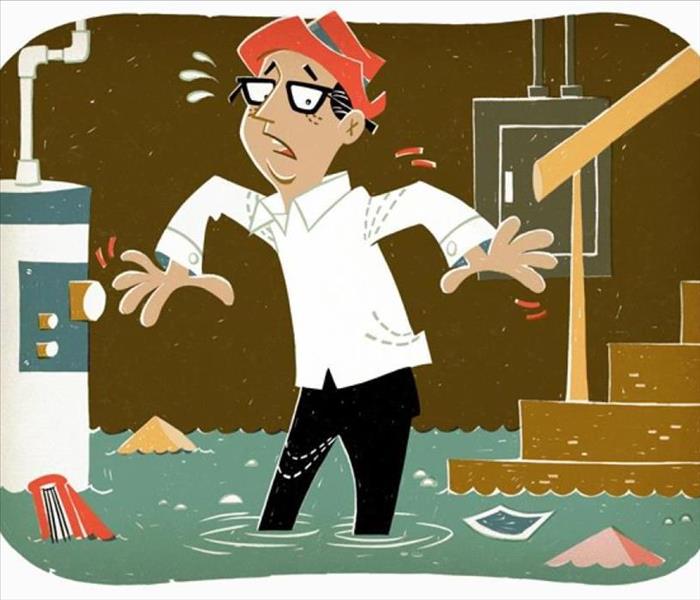
A flooded basement is not the best way to get that indoor swimming pool you've dreamed about. Burst water heaters cause a lot of damage because the tank will constantly try to refill.
With busted pipes, shut off the water immediately and repair the pipes. Remove water-damaged furniture and personal items to dry and salvage. Use a sump pump, wet-dry vacuum, dehumidifier and fans to drain the water and dry out the basement. Remove damaged sections of wall coverings (drywall, paneling) and insulation, and be sure to dry and ventilate wall cavities to limit mold and mildew growth. Track down the source if it's not busted pipes. You may need to excavate around the basement and apply a barrier to the exterior walls to prevent water from leaching through.
Contact your insurance company. Your water heater won't be covered (it may be under warranty, however), but any damaged items may be.
Sounds like a nightmare, so be sure to call SERVPRO OF EAST HONOLULU to reduce your stress and restore your home. Our goal is Working to make it "Like it never even happened."
Flood Safety Tips
1/14/2017 (Permalink)
Sometimes floods develop slowly and forecasters can anticipate where a flood will happen days or weeks before it occurs. Oftentimes flash floods can occur within minutes and sometimes without any sign of rain. Being prepared can save your life and give you peace of mind.
During a flood, water levels and the rate the water is flowing can quickly change. Remain aware and monitor local radio and television outlets. Avoid flood waters at all costs and evacuate immediately when water starts to rise. Don't wait until it's too late!
When flood waters recede, the damage left behind can be devastating and present many dangers. Images of flood destruction depict destroyed homes and buildings, damaged possessions, and decimated roadways. However, what you can't see can be just as dangerous. Floodwaters often become contaminated with sewage or chemicals. Gas leaks and live power lines can be deadly, but are not obvious at first glance.
What to do AFTER flooding:
- Remove excess water by mopping and blotting
- Wipe excess water from wood furniture after removal of lamps and tabletop items
- Remove and prop wet upholstery and cushions
- Place aluminum foils and wood blocks between furniture legs and carpet
- Remove colored rugs from wet carpeting
- Remove art objects to a safe and dry place
- Gather loose items from floors
What NOT to do AFTER flooding:
- Do not leave books, magazines or other colored items on wet carpeting or floors
- Do not use televisions or other household appliances
- Do not turn on ceiling fixtures if ceiling is wet, and keep out of rooms where ceilings are sagging
Water Damage from CONTAMINATED WATER
7/18/2016 (Permalink)
What to do when you have Water Damage from Contaminated Water:
- Avoid all contact with sewage and items contaminated by sewage.
- Wash your hands thoroughly after contact with contaminated items.
What NOT to do when you have Water Damage from Contaminated Water:
- Spread contaminated water by walking unnecessarily on damaged or wet areas.
- Turn on the HVAC system if there is a possibility of spreading contaminated air.
- Use household fans to dry the structure and spread contamination.
- Use products for personal hygiene and cleanliness if exposed to the contaminated areas.
Note: If exposed to harmful waste, OHSA recommends a post-exposure medical evaluation. Consult your local health department or physiciann.
Principles of drying a structure, #2, #3 and #4
12/31/2015 (Permalink)
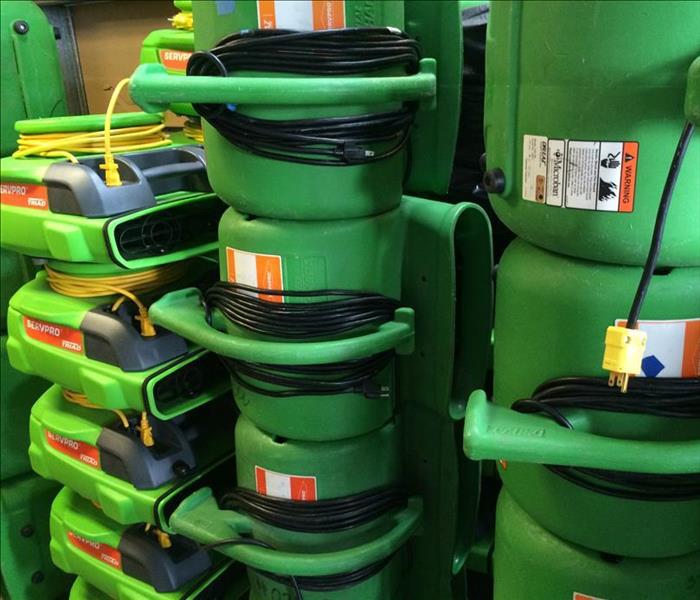 These are our air movers. They speed up evaporation (see principle #2).
These are our air movers. They speed up evaporation (see principle #2).
Continued.
The second principle of drying a structure is evaporation that occurs when water is moved from a liquid state to a vapor state in the air. Evaporation does not remove the moisture, it just moves it from the materials to the surrounding air. Once evaporation is occurring, the moisture can now be removed through dehumidification.
The third principle is dehumidification, or the removal of moisture from the air. This is achieved by using dehumidifiers—refrigerant or desiccant. The refrigerant ones are most effective in 70-90 F, and work by condensation. In simple words, the warm and moist air is drawn over cooled coils, causing the moisture to condensate on the coils and drain off via a tube connected to a sink or a toilet. Desiccant dehumidifiers are completely different technology, and work by adsorption or absorption. They remain efficient down to 32 F and even below.
The fourth principle is temperature control, which directly impacts evaporation and dehumidification efforts. Understanding of the correct temperature for each specific type of loss is extremely important.
This is all we wanted to share about the science of drying today. We will cover more on this topic soon. Stay tuned!






 24/7 Emergency Service
24/7 Emergency Service

